Public Pier — No Fishing License Required
Students of history should remember that Friday, November 22, 1963 was the day that John F. Kennedy was assassinated. For those who were alive during those days, the weekend that followed was a haunting melodrama still vivid more than thirty-five years later. At Imperial Beach, people’s emotions were torn. Saturday was the official opening day for the new pier and festivities were planned — but it is hard to be festive when the nation is in mourning.
Nevertheless, the pier did open and people quickly began to catch fish. Within two weeks, anglers had landed a 20-pound halibut, five-pound bonito, 4 3/4-pound sculpin (scorpionfish) and a six-foot-long leopard shark. Build it and they will come; that saying could apply to this pier. When fishing is good, they (the anglers) will come. Unfortunately, depending on one’s viewpoint, the success of a few fishermen resulted in unbelievable crowds during those first few weeks. As many as 3,000 anglers lined the rails, shoulder to shoulder. A tram operation scheduled for the pier even had to change its plans because of the crowding on the pier.
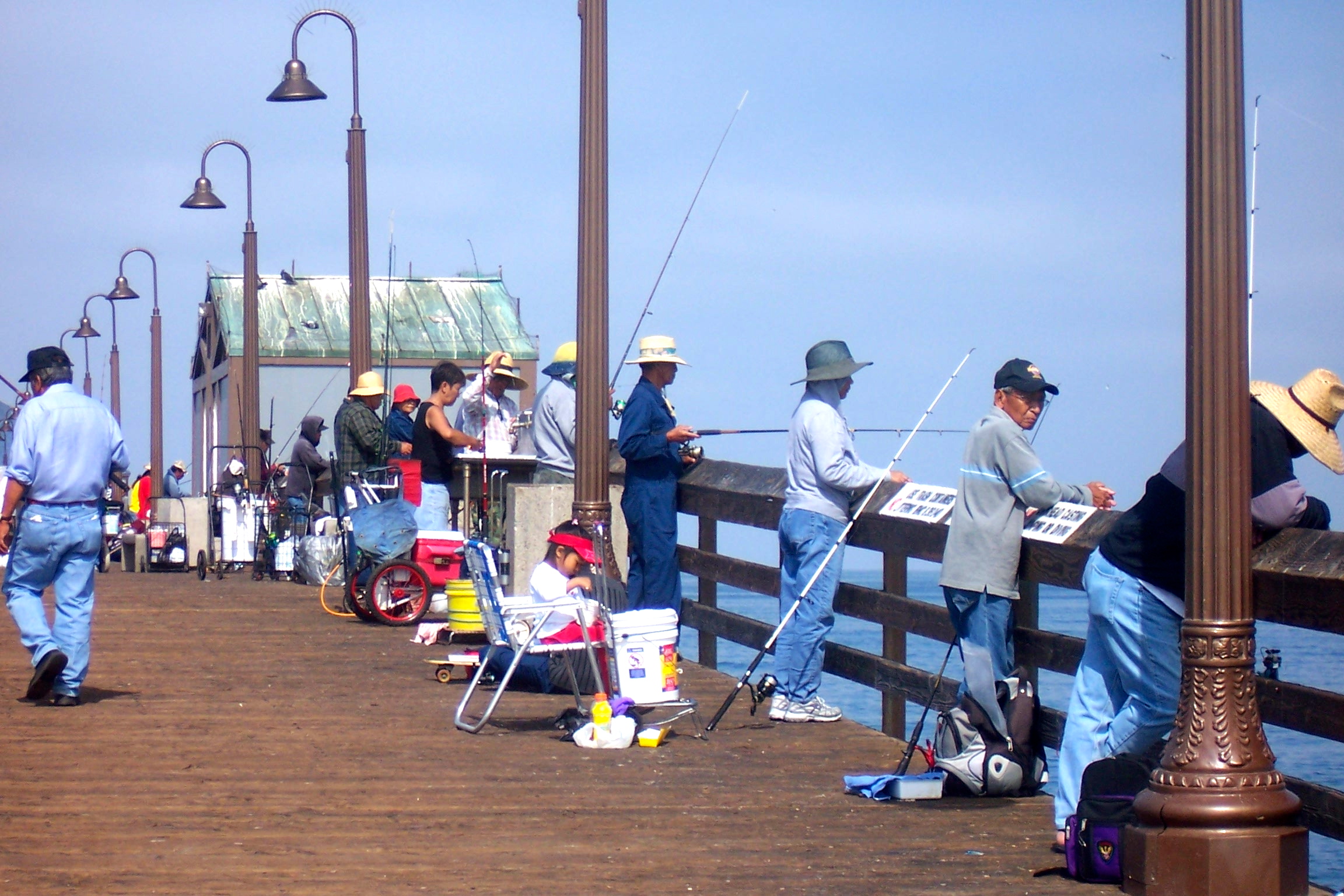
Stories about the pier appeared regularly in the local papers and a young angler named Ken Jones, recently transplanted from Newport Beach and the Newport Pier, began to visit and fish the pier. Action, although generally good, was rarely great. Better fishing seemed to exist north at Crystal Pier or in the bay at Shelter Island. Nevertheless, it became one of the piers I would visit during my high school and college days.
Environment. This is the southern-most pier in California (and the city proudly proclaims that it is the “Most Southwesterly City in the U.S.”). It is within walking distance of the Mexican border and displays, on most days, a beautiful view of the Coronado Islands (Islas Coronados), the four, fish-rich Mexican islands that sit just off to the southwest.
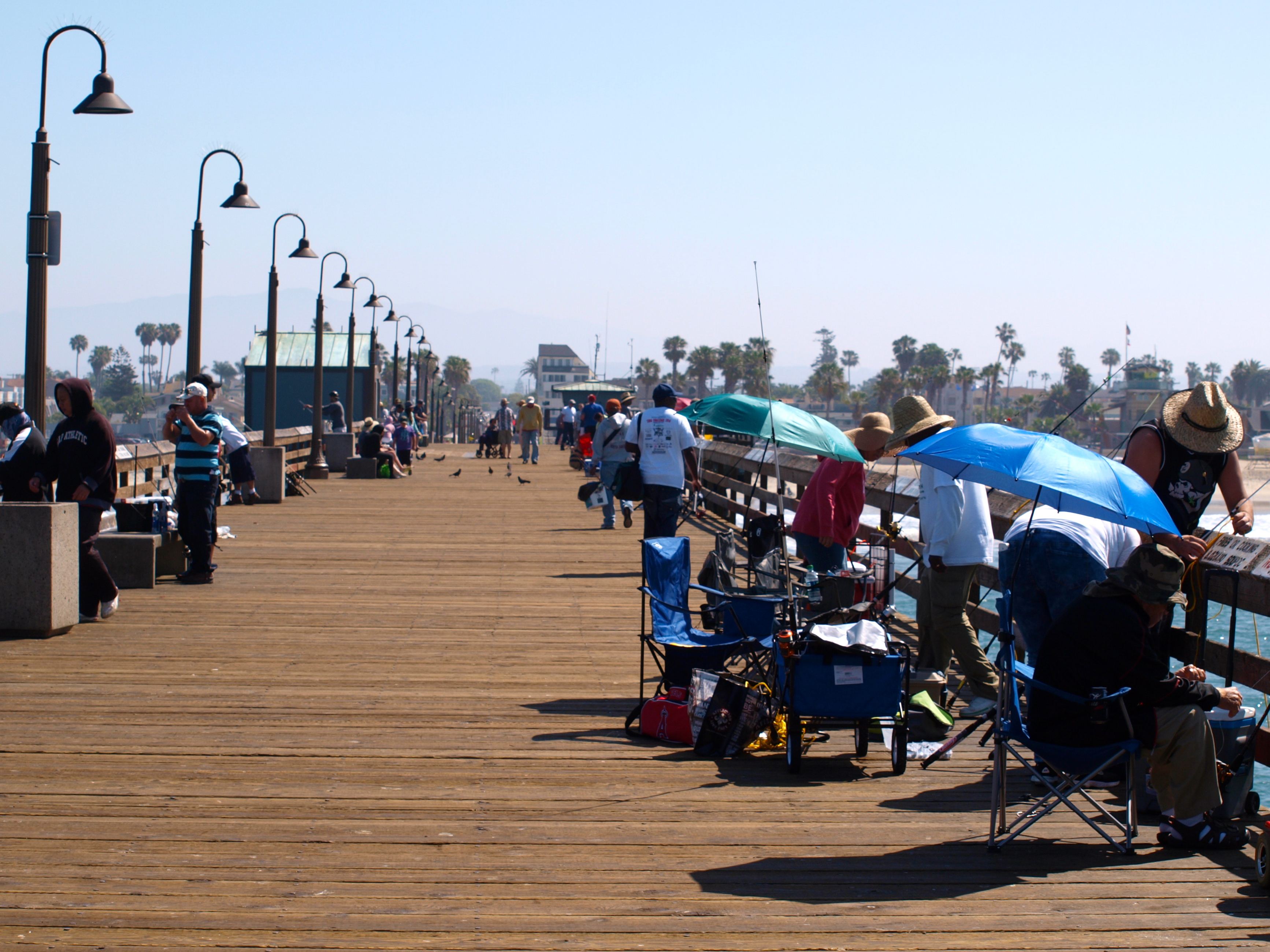
Unfortunately, the proximity to Mexico also leads to a fairly frequent, at least once a year, condition that tends to put a real damper on activities along the beach, including fishing. That phenomenon is sewage spills into the ocean from the Tijuana River. Sometimes a million or more gallons of untreated sewage flows into the Pacific just down-shore from Imperial Beach. When it happens, the “no swimming” signs inevitably go up and the anglers on the pier ask themselves if they really want to eat the fish from the water. Good question! Efforts have been made to improve the situation but to date the spills seem to continue.
The pier is located on a long sandy beach, has short finger jetties to the north, and extends out 1,491 feet into water that is nearly 20 feet deep. Several fish attractants exist under and around the pier. Pilings have a heavy growth of mussels and an artificial, half-moon shaped, rock reef was constructed near the end of the pier in 1964. Later, after a barge accidentally spilled a large load of boulders, an additional, although unplanned, reef was added to the mix. For the most part the fish found here are the normal SoCal, sandy-shore species. However, the reefs, and the deeper, calmer waters found at the far end of the pier do attract some additional fish.
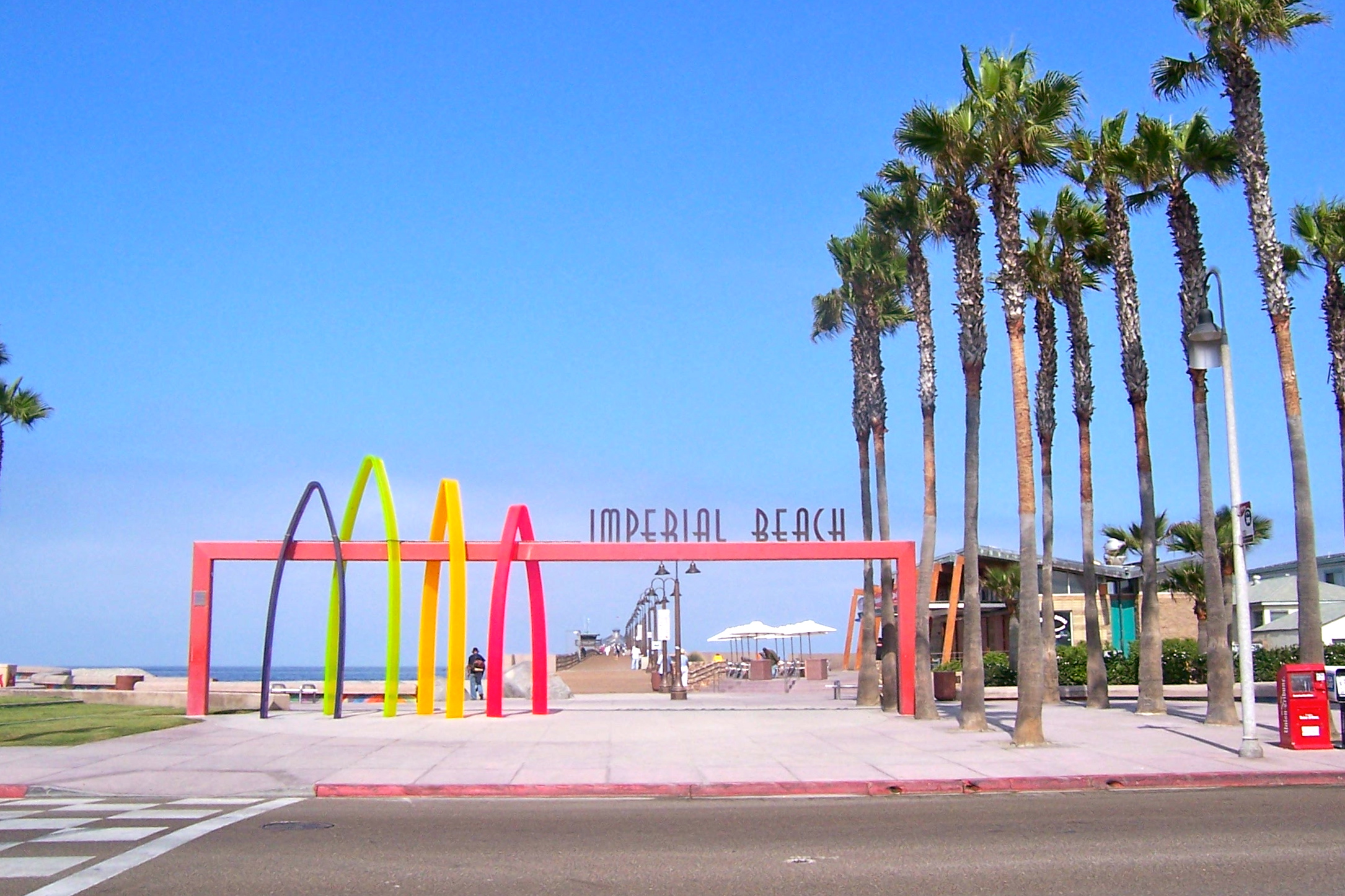
The Fish and Fishing Tips. For the most part the species are typical SoCal, sandy-beach, long-pier species. Best fishing here is behind the surf line (or in it) and about half way out where the pier begins an upward slope. The surf area itself is one of the better places to take both barred surfperch and California corbina. Just past the surf is tops for yellowfin croaker, spotfin croaker, and sargo; some years will also see some bonefish taken in this area.
On most any day you’ll see the knowledgeable “regulars” fishing the inshore area; newcomers seem to head automatically out to the end. The best bait for the barred surfperch is live sand crabs, but bloodworms, ghost shrimp, and fresh mussels will work for all the fish. Winter and early spring are the best times for the barred surfperch while mid-summer to fall are the best times for the croaker. Nighttime, during an incoming tide, is almost always best for the larger croaker, especially a high tide that measures five feet or greater. At night you might also see a few black croaker.
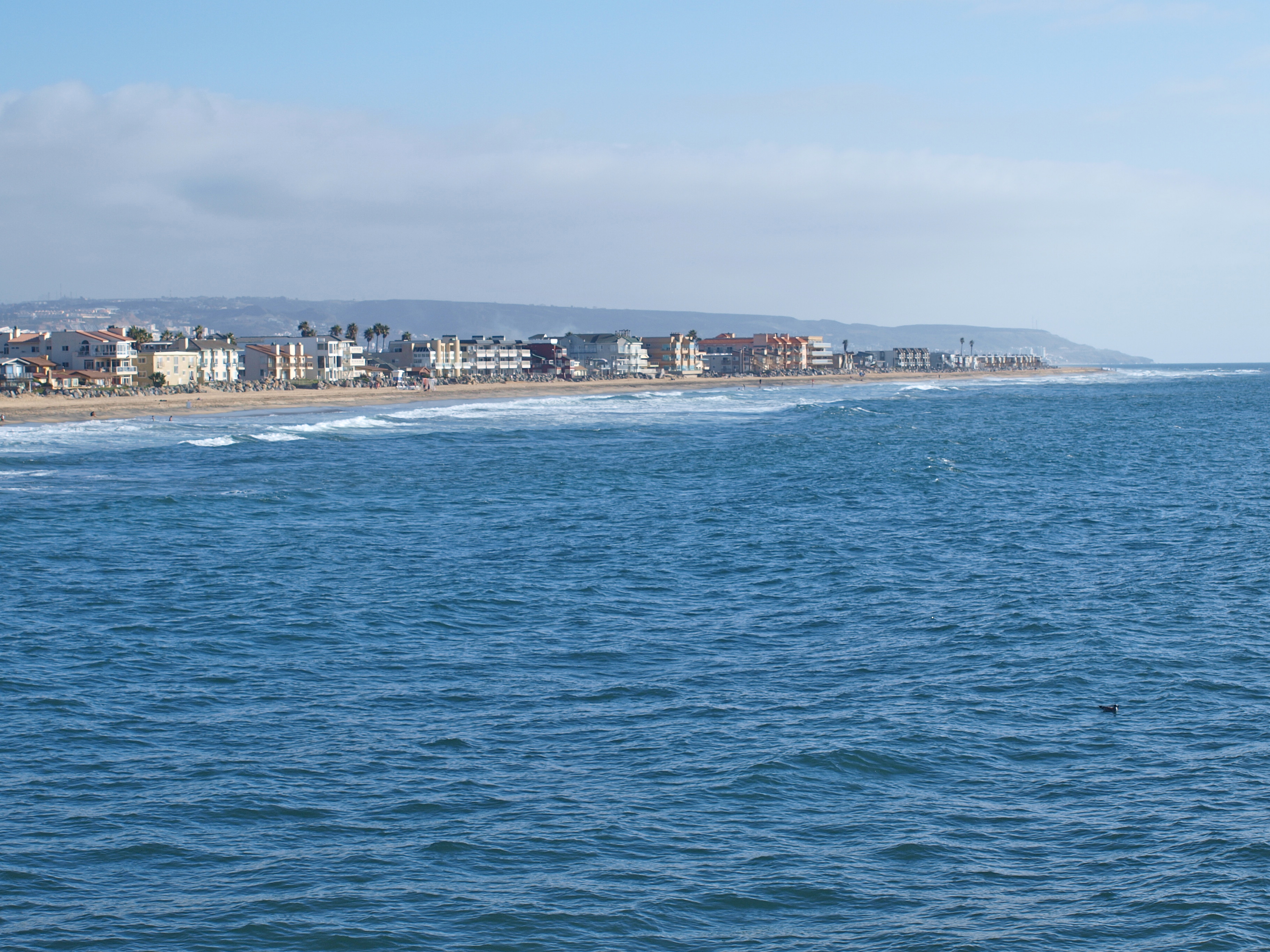
The shoreline looking south; it’s a short distance to Tijuana and the Mexican border.
Sharays too are common in the inshore to mid-pier area. Sharks include leopard sharks and gray smoothhounds as well as a not-a-real-shark, the shovelnose shark (guitarfish). Rays include the small thornback rays, round stingrays, butterfly rays (a few) and bat rays.
A fish starting to make an appearance at the pier is shortfin corvina. The Baja species that has shown up in South San Diego Bay waters over the past decade was rarely ever taken outside the bay until recently. However, grunion that showed up on the beach in July ’09 were followed by corvina. Quite a few big shortfins were recorded including one that was reported at nearly ten pounds; largest to be weighed was 6 ½ pounds. Most fish were caught on small spoons, MegaBaits or plastics like Fish Traps. Some were also taken on fresh mussels. Since then every year seems to see some corvina taken from the pier, especially when the grunion are running and most are caught in the inshore waters.
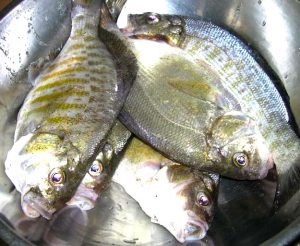
Barred surfperch
The second best area is the mid-pier area about halfway out on the pier. All of the aforementioned fish may show up but a couple of additional species predominate. The water here can harbor huge concentrations of queenfish (called herring) and walleye surfperch and almost every day will see whole families catching (or snagging) the small fish. Both the queenfish and walleye like to school mid-depth, usually about half way to the bottom (drop your rig to the bottom, pull up a couple of feet, and continue checking every couple of feet until you find the school). The most common rig for these fish is a multi-hook rigging (your own or a Sabiki/Lucky Lura-type bait rig) but a single, size 8 or 6 hook, on the end of a slightly weighted line, baited with a small strip of anchovy or squid, will often yield the larger queenfish and walleye surfperch. In addition, anglers jigging with small crappie jigs (generally white or yellow) often show impressive bags of medium to large size queenfish. I’ve also noticed that the schools of fish in this mid-pier area are generally on the north side of the pier, the same as at Ocean Beach and Oceanside. Another species is also common here, white croaker (called tomcod). It’s caught on the bottom and when schools are present numbers will be high. A variety of pelagics will also start to show in the mid-pier waters (see below).
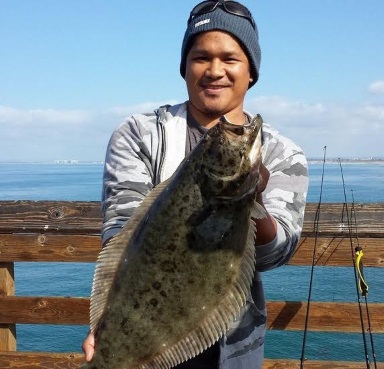
California halibut
The mid-pier area is (surprise, surprise) also one of the best areas for halibut with most of the flatties hitting from the late spring until the early autumn months. Halibut are “ambush predators” that like to lie on the bottom, eyes upward, and when they see a fish come swimming above they dash upward and grab the unsuspecting fish. As a consequence the best technique for halibut is a live bait and in this case any of the small fish in the mid-pier area— small queenfish, white croaker, and smelt (aka prey or food for the halibut) seem best suited to light up the eyes of a hungry hallie. The other technique is using lures that simulate live bait. Motionless bait sitting on the bottom rarely attract the halibut.
This mid-pier area also seems to be the main locale of the dreaded lizardfish, the skinny little fish that, when present, can seem to cover the bottom. The toothy fish, anywhere from six inches to 18 inches long (a big one) will hit almost any bait including bait that seems too big for their mouth. They sometimes can actually be difficult to keep off a hook. Although they’re considered inedible by most people, some of the locals do eat them. Others use them as halibut bait (and an angler using lizardfish as bait won a “big money” halibut derby in Santa Monica Bay. The good news is that they are a fish seen in cycles, often showing up for a year or two then disappearing for many years.
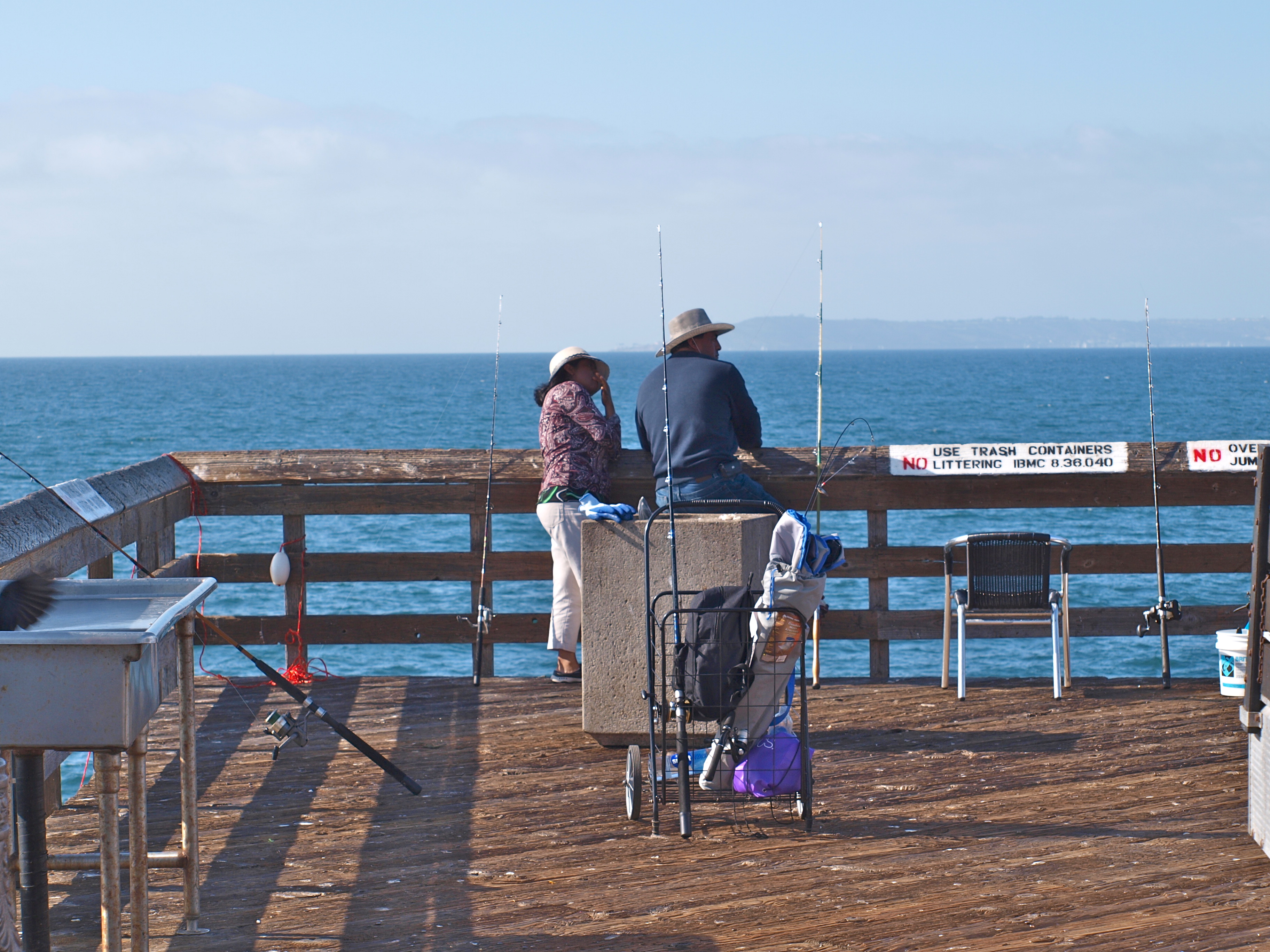
A fish that is caught from the mid-pier area out to the end, and often caught down around the pilings, is barred sand bass. The fish are known for spawning in the sandy flats south of Imperial Beach and when they do large numbers are caught by the Sportfishing boats. Given that many pass by the pier on the way to those spawning grounds, it’s easy to see why so many also get caught at the pier.
Two other species caught from both the mid-pier area to the end are white seabass and bonito. Both are favorites! Springtime may see a few white seabass but usually they will be the younger fish that are generally called sea trout (although a huge white seabass was taken in 2014 at the end). Bonito will show up some years, typically warm-water years, and when they do big numbers can be caught. Unfortunately, the smaller, younger bonito are not too discriminating and can be caught at times on bait rigs, Sabiki’s and others, and they are often caught three to four at a time. A couple of drops will yield the five fish limit for the smaller bonito (which has an overall ten fish limit) but way too many anglers just keep catching them one after another. Some big fines could be given out by the CA Fish and Wildlife wardens but rarely are they around to ticket the anglers.
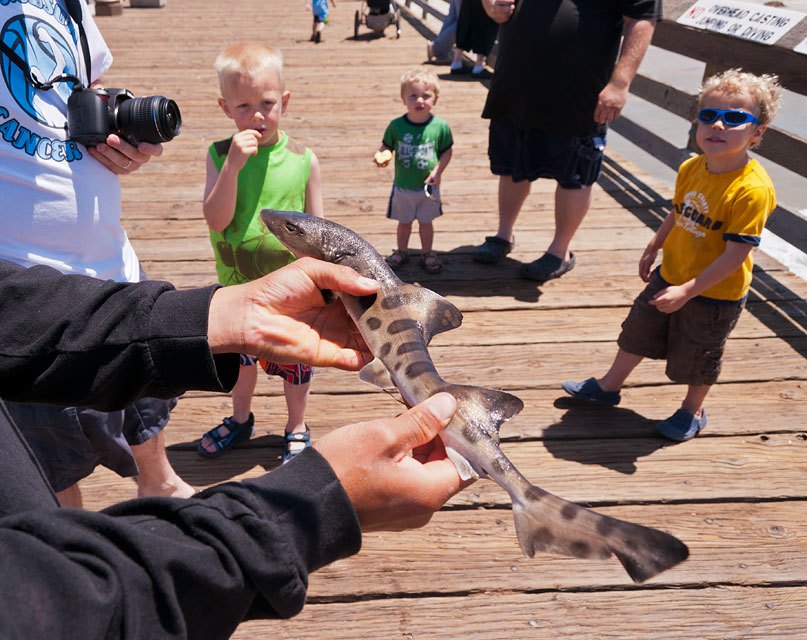
Small leopard shark
Luckily the larger bonito are a little harder to catch. Most of them fall to either live bait, i.e, anchovies, or a lure such as the long-time favorite bonito feather trailing a Cast-a Bubble or more recent lures like MegaBaits. The big bonito give one of the hardest fights, pound for pound, of any pier fish and when they show up the pier will almost always be crowded with anglers.
Two other pelagic species can enter the mix at times—barracuda and yellowtail. Both tend to show up August through September or October when the water is warm and while the yellowtail typically fall to live bait both can also be caught on lures, i.e, Krocodile and Kastmaster for the barracuda, MegaBait for the yellowtail.
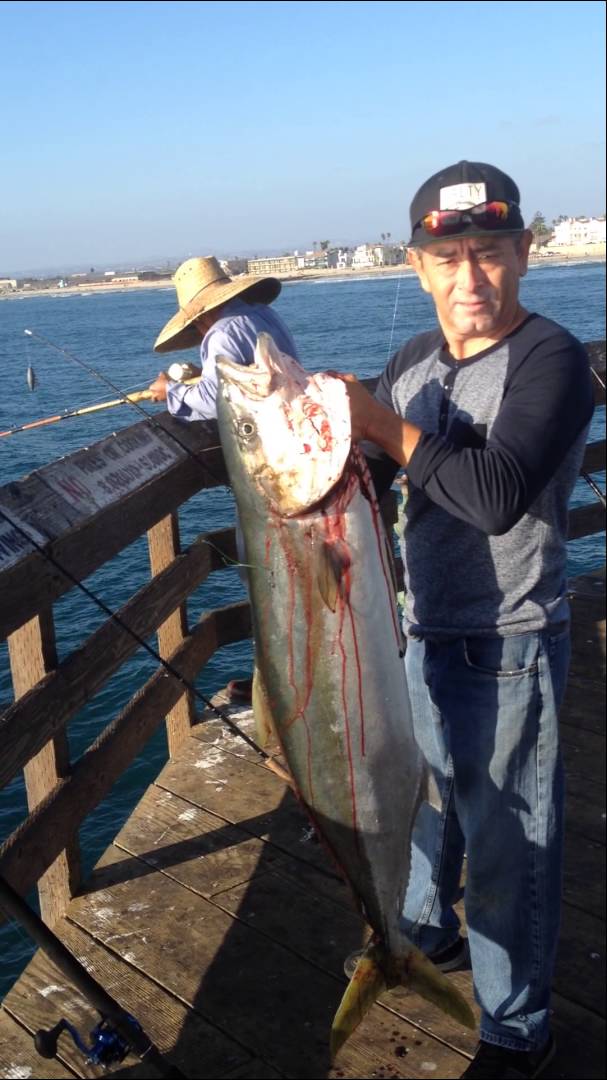
A good-sized Yellowtail
Down around the pilings is the area where you find the largest perch. Pileperch, blackperch (buttermouth perch), and rubberlip perch will fall to bloodworms or fresh mussels fished on small size 6-8 hooks. Try different depths, but most of the pileperch are caught just a couple of feet beneath the surface of the water while the rubberlip and buttermouth will be down on or near the bottom. Watch your leader closely to prevent it from being washed into the pilings and their sharp-edged, leader-grabbing mussels.
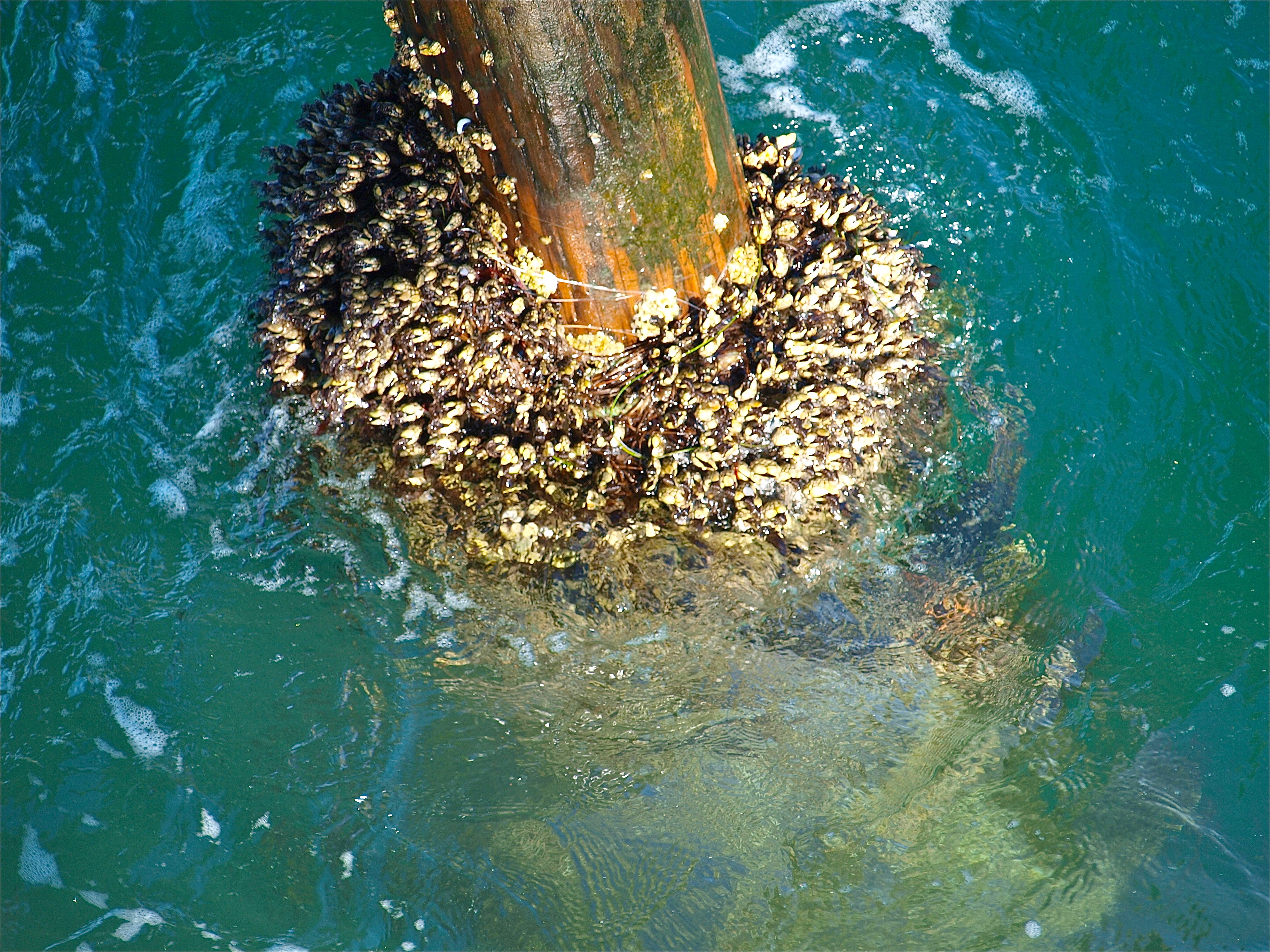
Two perch-like species may also make a showing—opaleye and halfmoon. Both will often be found by the piling or between them, usually a few feet underthe surface of the water. The Bible on opaleye says frozen peas are best but I’ve found that both opaleye and halfmoon love ghost shrimp (as well as worms, fresh mussels, and pieces of market shrimp); the halfmoon will also hits strips of squid.
The end section seems best for California scorpionfish (sculpin), a tasty fish but one which must be handled with care due to their poisonous, very painful spines. The fish can be caught with a variety of baits—squid, bloodworms, cut anchovy, market shrimp and ghost shrimp but a strip of squid seems best. Usually the best time for the sculpin is after dark, especially during the winter months.
Although the scorpionfish is commonly called a sculpin it is actually a member of the rockfish family. A true sculpin, the cabezon, is also occasionally caught at the pier, most commonly out toward the end and often down around the pilings. Fresh mussels, squid, bloodworms, market shrimp, ghost shrimp and cut bait will all work for the “king” of the sculpin.
Although fairly uncommon, a few lingcod have also been caught in this area (try a live bait such as a small queenfish). Also uncommon, but seen in greater and greater numbers are giant (black) sea bass; every year will see a few. Just remember they are illegal and if hooked must safely be released.
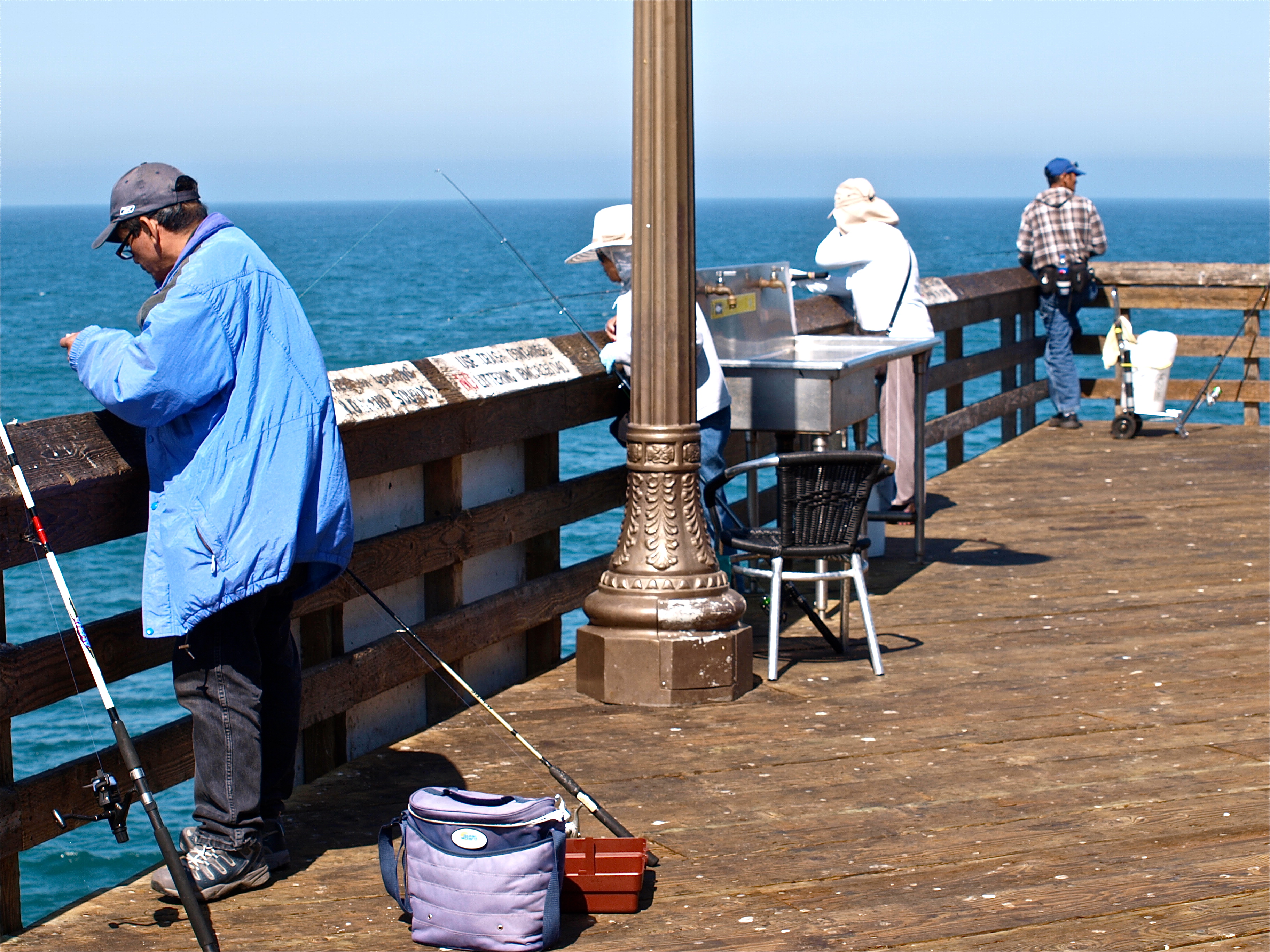
At the end
This deeper water area is also generally the best area for the larger sharks and rays as well as the sharkers — the guys seeking out the bigger sharks. Although most of the sharks will continue to be such species as leopard sharks, shovelnose guitarfish (aka shovelnose sharks), or bat rays, the sharkers for the most part really are seeking out the large thresher sharks or something even larger (perhaps a 7-gill shark, a mako shark, or even a blue shark). Thresher sharks 6-10 feet in length are fairly common and large 7-gill sharks were taken in both 2015 and 2016. Although still a relatively rare sighting locally, a great white estimated at 16-18 feet in length by shark experts was seen close to shore in 2012. The great white of course is illegal to pursue, catch or keep.
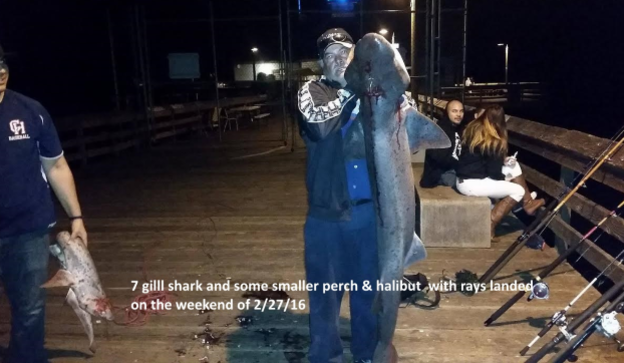
7-Gill Shark caught in 2016
Even though the numbers and sizes of most of the sharks aren’t that large, that doesn’t stop the stories. One day my son Mike and I were calmly catching fish at this pier when a stranger walked up and asked if we minded sharing the area. Of course, we didn’t, and it turned out to be a wise decision. We were enthralled as we listened to some of the most interesting stories we had heard in a long, long time. The stories involved tuna boats, helicopter jobs (and crashes) in Africa, spies, insurance fraud and similar far ranging subjects. Apparently suffering from paramnesia, the veracity of the stories was unclear but the forceful and flamboyant nature of the teller was never in doubt. He said he lived nearby and was out on the pier to catch a tiger shark. “You know,” he said, “a number of huge sharks have been caught off of the pier.” To catch them he came equipped with a truly heavy pole (one better suited for fighting a marlin from a boat), a huge Penn reel, and a wire leader equipped with, I would guess, about a 16-0 hook. He stuck a whole mackerel on the hook, tried to cast it out (not too successfully), set down on the lawn chair he had brought, opened a beer, and then regaled us with his stories. After an hour, and no bites, he bid adieu! As said, large sharks are occasionally caught here but most often it’s a thresher or a 7-gill and you only need medium to light-heavy tackle, not the monster tackle he possessed.
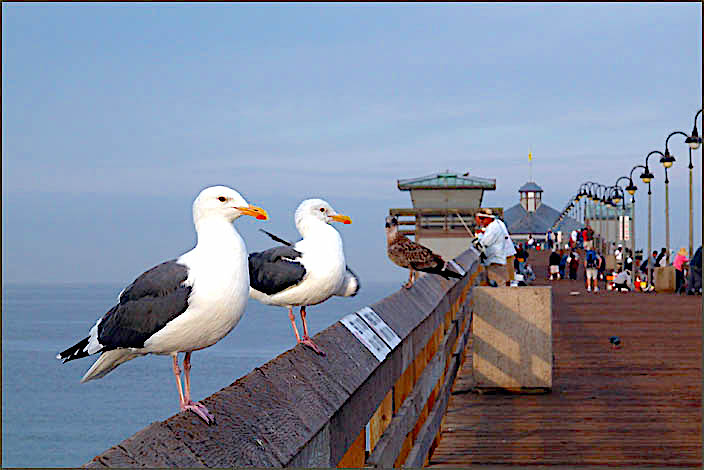
Another time, Mike and myself were fishing out toward the end the pier and catching far too many mackerel. In fact, we became somewhat bored given the ease with which we were catching fish. We finally decided to move to the shallower waters to see if we could catch some croakers or perch.
Just inshore from the restroom area stood a petite lady catching queenfish. She would cast out her leader, a multi-hook affair, let it bump the bottom, give a couple of jerks, and pull in a fish on nearly every cast. We fished next to her for ten minutes without a fish. Finally, this famous pier fisherman and author (yours truly) wandered over to her to see what she was using. She said she had the right jigs! The leaders were homemade and she sold them for $2 each. Unwilling to be further embarrassed, two of the leaders were purchased.
Author and son tied on the leaders and soon both were catching the queenfish; although the first fish caught was a small bonito that had the unfortunate audacity to strike the leader. Each leader had a number of green-colored flies with size 4 gold-colored hooks. I’ve used similar multi-hook leaders, and seen others use similar leaders, but I had never seen any leader work quite as well as those that this little ‘lady’ made.
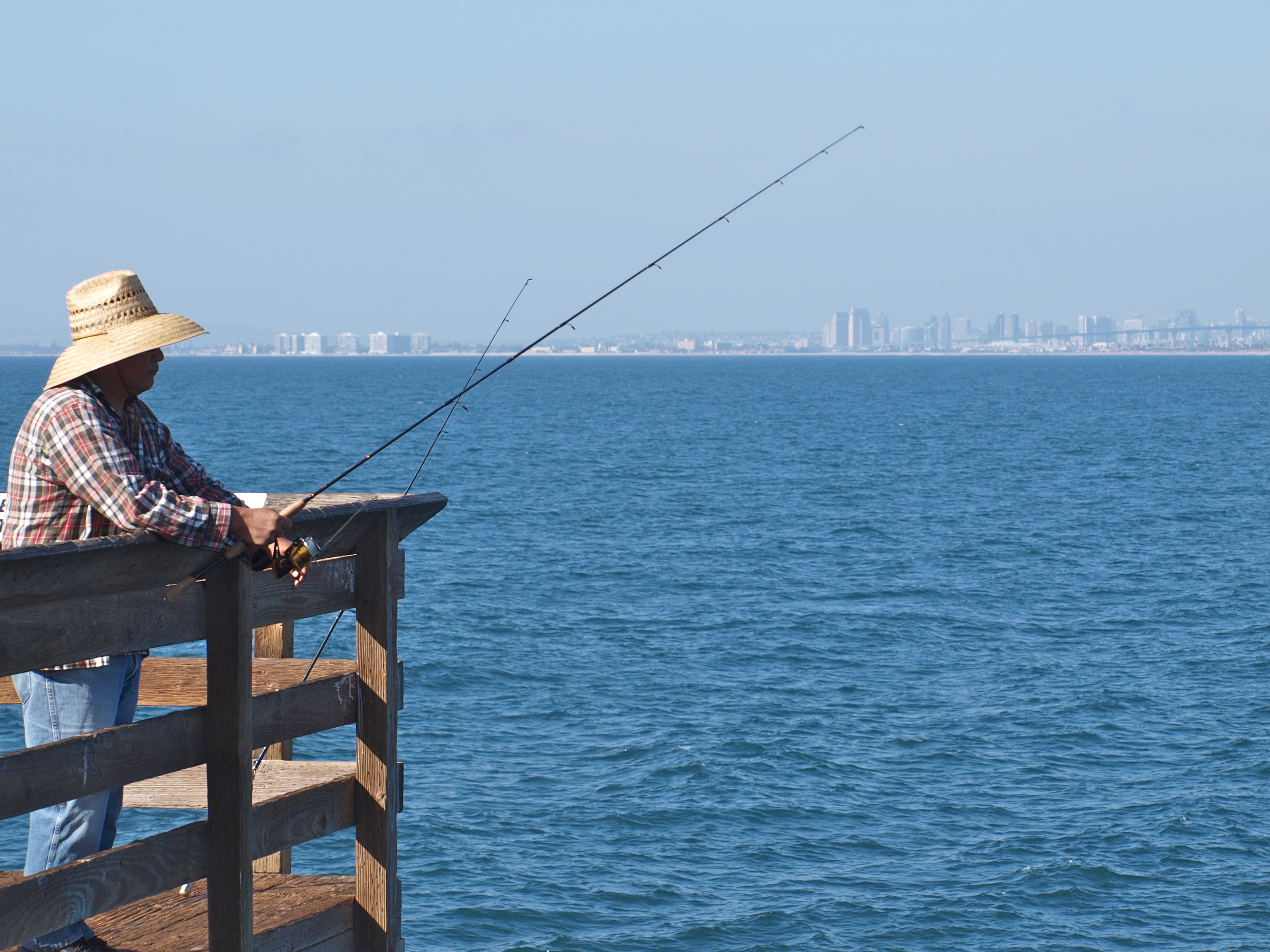
It’s only a short distance to San Diego and its increasingly impressive skyline
Almost every area of the pier, from the surf line to the end will often see huge schools of the smaller pelagics—mackerel, jacksmelt and sardine. All three can be in evidence throughout the year although jacksmelt numbers always seem to peak during the winter months.
Sardines were rarely seen for decades due, most thought, to over fishing by the commercial fisheries, but they began to see an upsurge in numbers in the early nineties before once again plummeting around 2010. However, their numbers once again seem to be on the rise.
Although mackerel numbers were somewhat low in the 1960s’ (when the number of bonito was amazing) they’ve been around in large numbers almost every year since the late ’60s.
Sometimes all three species are present and you can usually be assured of good numbers of fish if you are seeking them out. Sibiki bait rigs have become the favorites for all three although I only use the Sabikis for sardine. For mackerel and jacksmelt, I prefer a high/low rig with size 6 or 4 hooks and a one-ounce torpedo sinker on the bottom. When using a Sabiki you normally do not need any bait. However there are times with both the mackerel and jacksmelt want a little piece of bait on the hook. I’ve always used pieces of mackerel or a small strip of squid for the mackerel while jacksmelt take a variety of baits—bloodworms, small pieces of market shrimp or a cut piece of fish.
Of course sometimes the mackerel are in their patented “mac attack” mode and anything you throw out will attract them. The Sabiki-lovers will pull in a mackerel on nearly every hook but inevitably three or four mackerel will tangle that Sabiki in an unmanageable knot and the Sabiki is only fir for the trash can. Sometimes the mackerel are a little less frenzied although their number and fight is the same. When this is the case tie a single hook (size 6-2 depending on size of the mackerel) baited with a strip of squid or a piece of mackerel and retrieve slowly for the hoped for fish. If that doesn’t work, fish the bait under a float. Often the macs will also show a morning bite or early evening bite that begins as the twilight is fading. In the dark use a glow stick above your bait. It seems to help attract the mackerel and it’s cool watching all the glow sticks heading every which way while the anglers are scrambling to keep their lines from tangling.
Crustaceans. Although the pier is not noted for crustaceans, two species are caught fairly often. The first is spiny lobster and anglers are out every lobster season seeking out the bugs. Unfortunately, many are also caught on fishing lines (illegal), some are caught out of season (illegal), and some are under the size limit but still kept (illegal). It’s an ongoing battle.
Crabs too can be caught but for the most part the crabs that are caught are spider (sheep) crabs that look a little gnarly. Most people look at them and them throw them back not understanding that they are good eating (although a little hard to clean).
Exotic or Unusual Species. Given the location of the pier, the closest pier to Baja, I’ve always thought that the pier would show some exotic species from the south, species rarely seen at California piers. However, we have not had a reliable reporter over the years to provide good input on the catch at the pier. Recent input from “Mav,” a longtime angler in the area has provided some interesting feed back. Mav said, “You heard about the Black Skipjack that showed for three days at Imperial Beach Pier in 2015? Everybody made the promise to keep quiet the first day and nobody went to work the next day. Lol. Nasty fish if you don’t prep them right. They have to be bled and prepped to be eaten raw. Any heat to the meat and it’s cat food (throw-up face). Three small random Sierra were caught by different people that year also.” The report may be the first record of black skipjack and sierra (mackerel) being caught from a California pier (although sierra mackerel were reported from the Hotel Del Coronado Pier in the early 1900s).
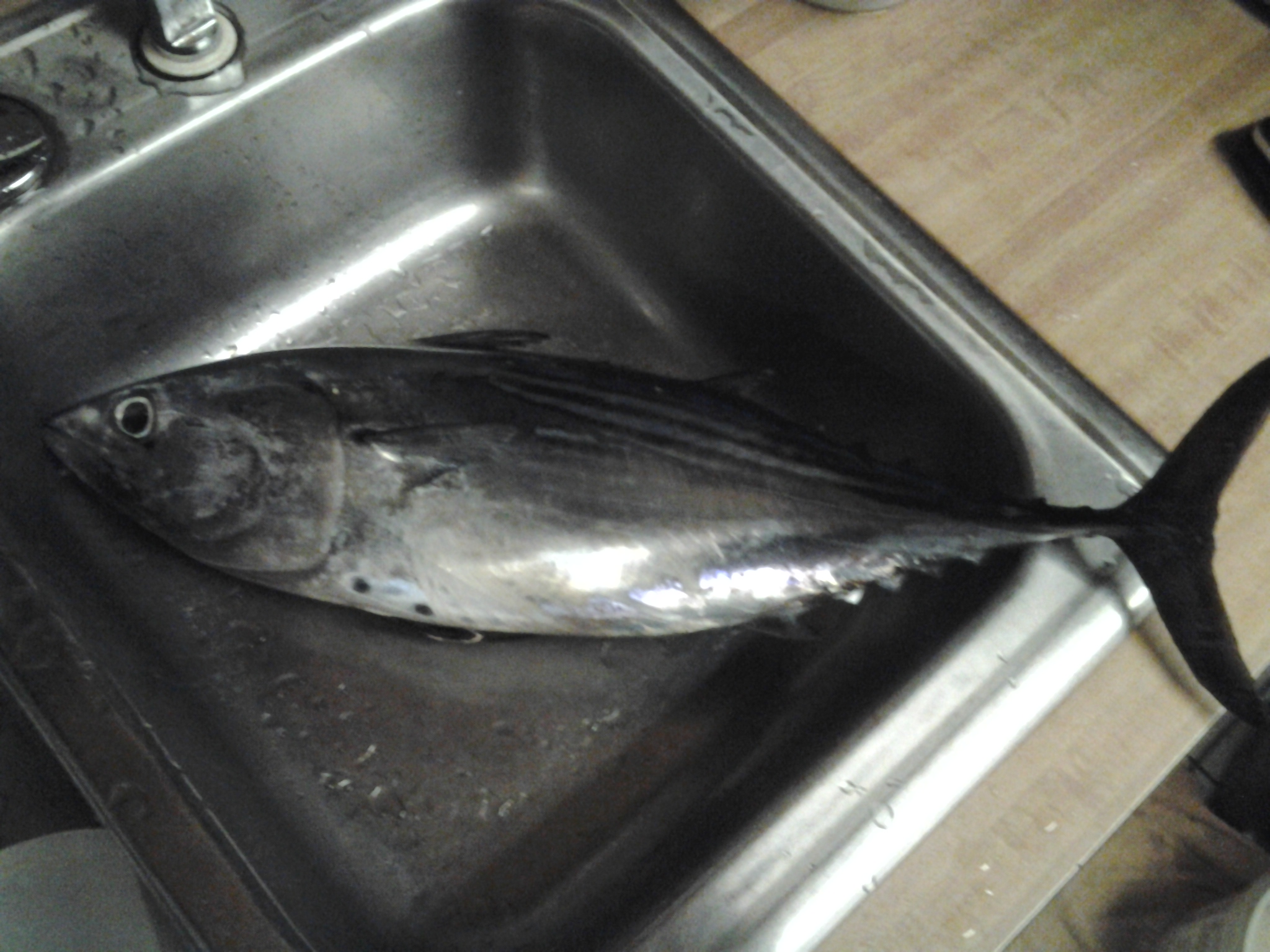
Black Skipjack — 2015
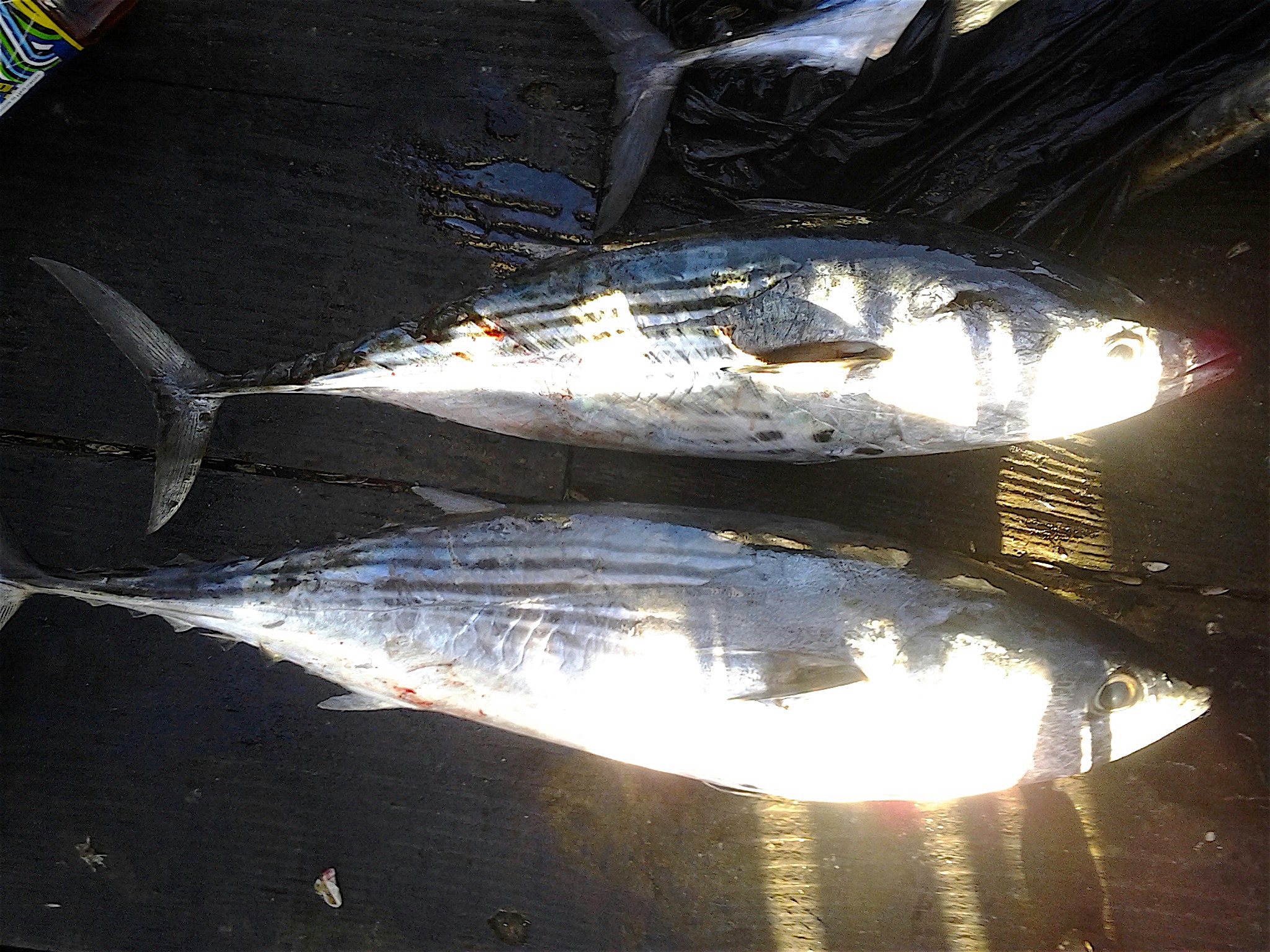
Strange Catches On Fishing Pier
Two fish which were far from home waters were caught off the Imperial Beach Pier this week according to Ralph ” Big John” Johnson, operator of the bait shop there. Ordie Weller, Imperial Beach, caught a 5 1/2 pound ling cod in the shallow waters beneath the pier. Shortly thereafter Angelo Asuncion, San Ysidro, landed a 3 1/4 pound silver salmon. A ling cod is normally caught in more than 200 feet of water and the silver salmon is normally only found in Northern California.
—Chula Vista Star-News, April 9, 1967
John Slagle, Chula Vista, landed what Imperial Beach pier people say is one of the biggest cabezones ever caught in these parts. It was a seven pound, two ounce beauty and there’s no doubt about this one. The pier people snapped a picture of it and hung it on the wall in case there are any non-believers.
—Chula Vista Star-News, March 27, 1966
The Pier Rats Speak — A few messages to the Pier Fishing In California Message Board
Date: October 20, 2003; To: PFIC Message Board; From: adiefish123; Subject: Imperial Beach Pier WFO! 10/20
After hearing the inside scoop about the recent hot bonito and mack bite from some nearby locals, I decided to scout I.B. pier to see for myself. Decided to pack light, so I carried my trusty ol baitcaster and a couple 5/8 Krocs, prizm and blue-striped. Fished from 430-600pm. Flurries of bonito and jumbo-sized macks towards the end of the pier, with the majority of the bonies being caught behind and alongside the restaurant. However, it’s crowded as hell at the end. I managed to squeeze in for a few mins hoping to score on a couple of boneheads but instead landed a couple of large mackerel, id estimate between 2-3 lbs! Apparently red tide has struck IB and cleared last week, and there has been a resurgence of sardines and anchovies congregated around this pier. Since then the fishing has been consistent and hot! A couple of legal hallies were caught midway on live sardines. Setting was perfect, kelp paddies everywhere to go along with perfect weather. SD crew if you’re out there, I strongly suggest to get in on the fun before the bonito start heading back south. Tight lines, adiefish123
Date: February 10, 2004; To: PFIC Message Board; From: mocteuzoma; Subject: Imperial Beach Pier
I’m from San Ysidro (southernmost part of SD) and although I’m currently studying in LA, I would have to say that I catch at least one fish at the Imperial Beach Pier 90% of the time. It depends what fish you are targeting but a good bet is to throw 3” and 4” swimbaits next to the restaurant (between the tables and chairs and north of the gate). This is a good area b/c there there is a sandy bottom next to a big rock structure that has the potential to attract halies. Big sculpin are always a nice catch in addition to other shallow water rockfish. If that’s not working, try the surf zone. Throwing small grubs at surfperch can be a blast on light line and there are some big perch there, up to 2/3 lbs. Depending on tide, try the first concrete bench to as you walk on the pier that’s on your left (the left is usually the most productive side but I suggest moving around too). Hope this helps, good luck.
Date: July 24, 2004; To: PFIC Message Board; From: skrilla; Subject: IB Pier 7/23 bonito, sharks, rays…
Well, got to Imperial Beach pier on Friday at noon with my brother and his friend. We set up at the end behind the restaurant. First half hour was depressing. No fish in sight. I was thinking of calling it quits until all of a sudden we see huge schools of sardines come up from the bottom. I mean they swarmed the whole pier. Birds started diving miles up and down the coast. Moment’s later schools of mackerel show up going up to 14 inches in length. Mackerel after mackerel all day with jacksmelt mixed in till the sun went down. Saw a fair amount of bucketfuls throughout the day. Saw many bonito attack the pier every now and then too, most being little 1-2# class fish. We used 3/8 oz Krocs to get them because they were only taking jigs. Lots of shovelnose taken from mid pier to the end, biggest one going over 20#. Saw a nice mako, thresher, and also a nice 32-inch halibut all taken towards the end of the pier. Didn’t really see much going on mid-pier but heard of a few yellowfin croaker taken. As soon as the sun started setting we looked down and saw literally hundreds of rays heading out to sea. I managed to catch one off the bottom. Weird seeing so many rays just feet off the surface all heading out to sea. I wonder what they’re up to. And to end the day we see a nice pod of dolphin come and play for a bit. All in all today was one of the best days I’ve spent on a pier. Reminds me of the El Nino days of ’98.
[This large assemblage of rays is somewhat common and is called “a fever of rays]
Date: September 4, 2005; To: PFIC Message Board; From: jmobfishen; Subject: Imperial Beach Pier Sat 5pm 10:30pm
First time here. We hit the pier at 5:30. Fished at the beginning of the piers incline and on the right side. First cast my girls Ash and Alex were pulling in nice size sardines, which I immediately live, hooked on the big poles. This went on till sunset. I had had a few hits but no big fish, but then the clicker started rattling and a hook was set. And though I have caught many rays up north in the bay and ocean this was a new one for me. One guy on the pier referred to it as a butterfly ray….hhhmmmm. Not sure…. definitely different no real tail, very light in color not nearly as dark as most rays I’ve hooked. 25 to 28 in wing span 10 to 15 lbs with a decent fight in it. Once the sun was down it switch from dines to small queenfish/croakers, lizardfish and few smelt and macs mixed in. And right before we were going to leave Ash reels in a 2-ft plus eel. Not sure what type. I have seen a few moray’s hooked on OB and this one was very different much stiffer of a body. It’s gonna take me a bit to become familiar with some of the different variations of fish caught up on the central and north coast areas. We fished till 10:30. No other big fish hooked.
Here’s the totals—50 plus Sardines; 10 to 15 macs; 10 plus Lizards; 10 to 15 queens; 2 small perch; One interesting “butterfly ray”; One even more interesting 2-ft non-moray eel of some kind; All released except for dines and a few macs and smelt for bait.
Date: August 30, 2007; To: PFIC Message Board; From: Ken Jones; Subject: I heard an angler caught a “live” hand grenade…
at the Imperial Beach Pier on Wednesday. Apparently the bomb squad came out and disarmed it. Now that’s a catch and I’m surprised no one got hurt. BTW, how can you have a “live” hand grenade in the ocean? Wouldn’t they degrade? Of course I don’t know how long it was there. AND, how did it get there?
Posted by: SturgeonSlayer23
THIS should be “The Deadliest Catch”
Potpourri — Perhaps more than you want to know about the Imperial Beach Pier
<*}}}}}}}}}>< — The pier makes a beautiful setting for pictures —
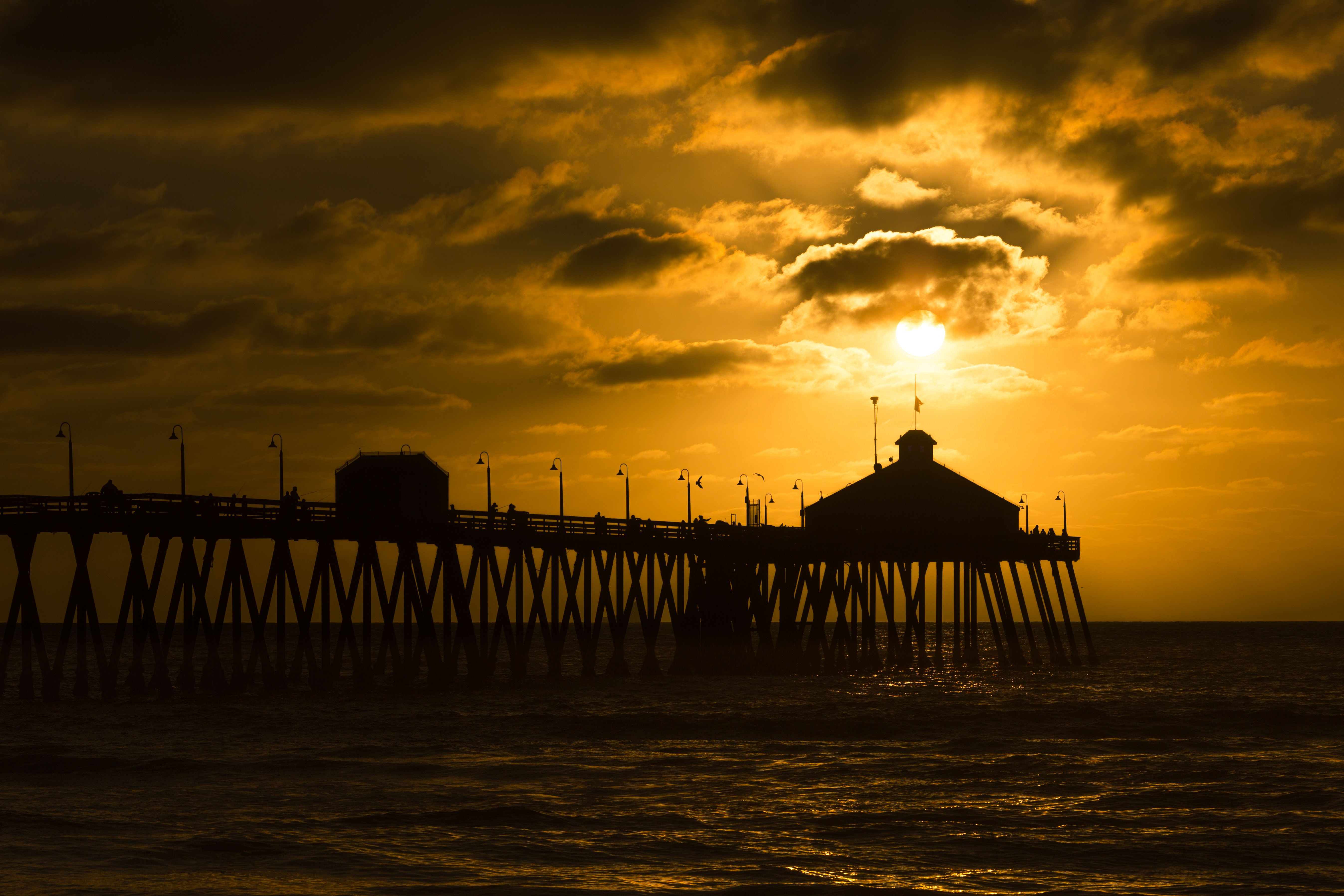
Picture by Patrick Fore and Upsplash
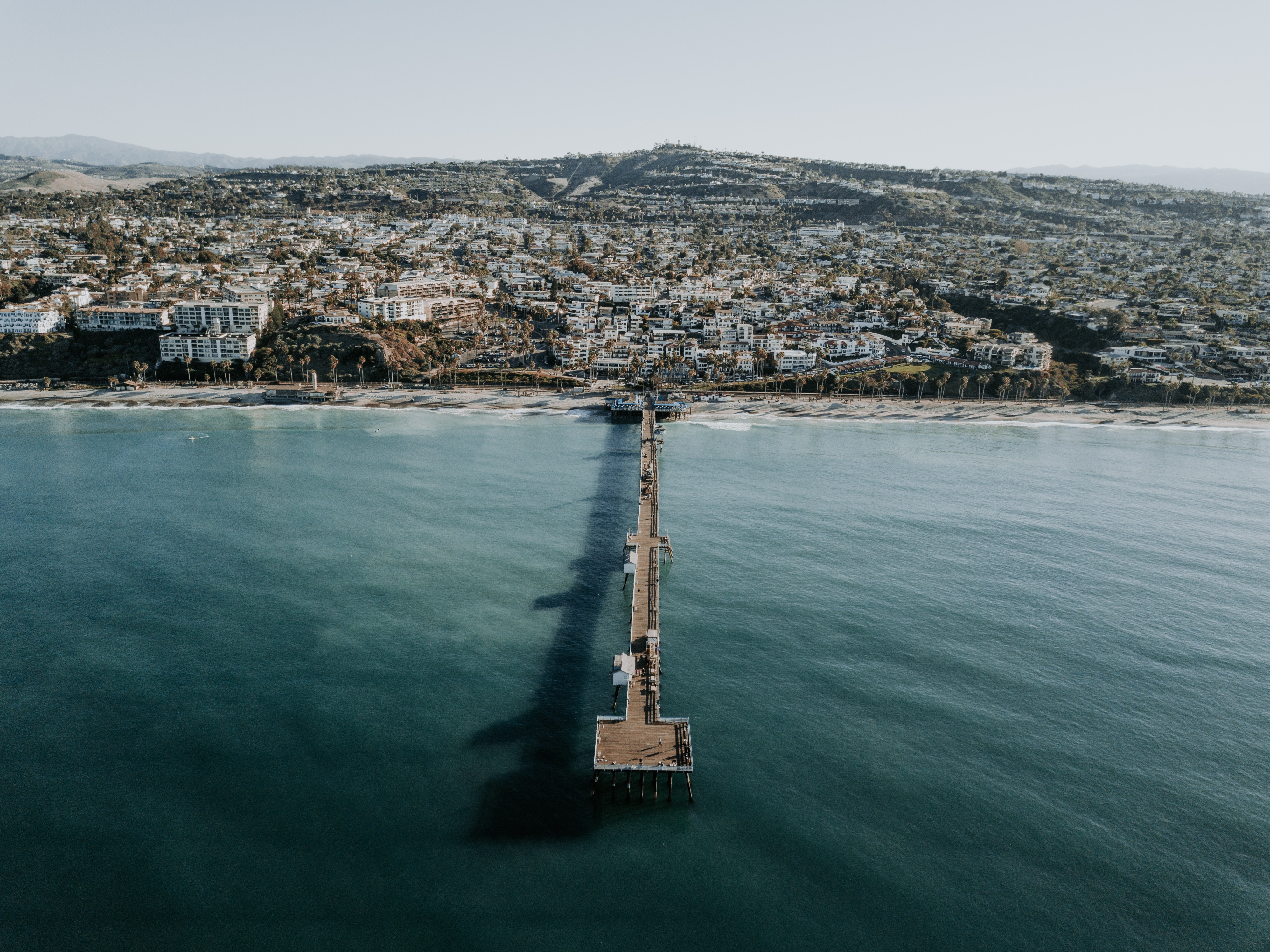
Picture by Jessi Pena and Upsplash
A couple of photographic sites —
https://www.flickr.com/photos/samantonio/26753231899
http://www.oceanlight.com/log/imperial-beach-pier.html
<*}}}}}}}}}>< — Fish surveys done by the California Department of Fish and Game from 2004-2009 showed a large number of species, 34, at the pier. Leading the list numerically were several schooling species, some of which were present during warm waters years but totally absent other years. The fish (listed numerically) — Pacific sardine, Pacific mackerel, jacksmelt, bonito, walleye surfperch, queenfish, northern anchovy, barred surfperch, topsmelt, yellowfin croaker, white croaker, jack mackerel, barred sand bass, black seaperch, shinerperch, spotfin croaker, silver surfperch, rubberlip seaperch, corbina, bonefish, California scorpionfish, sargo, spotted sandbass, calico surfperch, white seaperch, halibut, white seabass, cabezon, striped mullet, speckled sanddab, pileperch, shovelnose guitarfish, thornback ray and Mexican scad. Interesting are the number of bonefish (rarely reported), the small number of halibut, pileperch and sharks reported, and the total lack of any kelp bass. As mentioned, the very high number of schooling fish caught when present, i.e., sardine, can also give somewhat misleading figures.
<*}}}}}}}}}>< — The number one problem at the pier (in my opinion) is city officials! Surfers and swimmers are supposed to stay away from the pier but some do not follow the regulations. Instead they yell bloody murder if they swim in among the fishing lines and get hooked. In response the city places more and more restriction on the inshore surf area of the pier, the prime area for anglers to catch corbina and croaker. Perhaps the city forgets the role anglers played in helping the pier get built and the role of the California Wildlife Conservation Board?
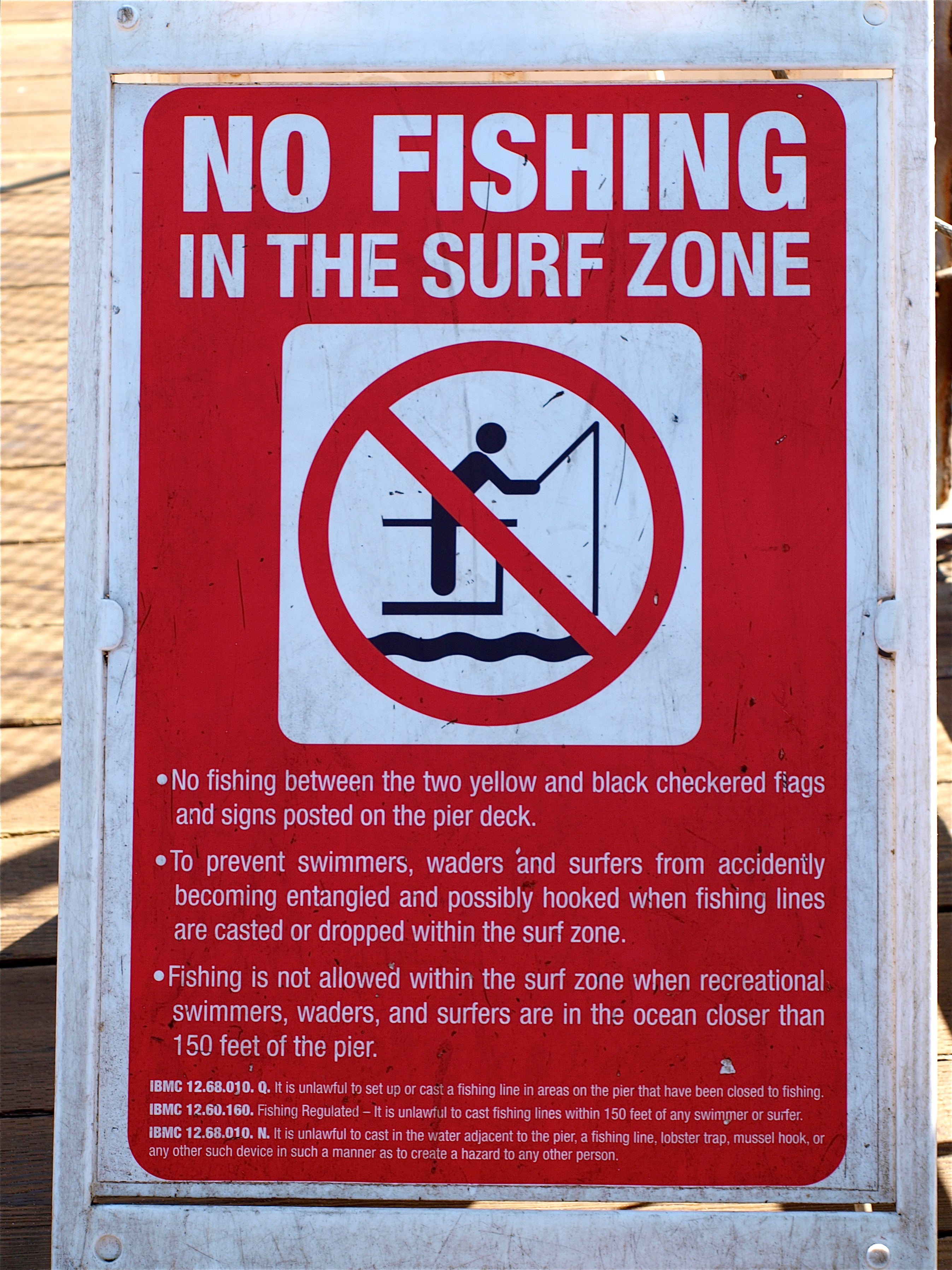
<*}}}}}}}}}>< — One day I received the following message from paul_e_easter who worked for the California Department of Fish and Game. It said: “Over the last couple of years the ROADNet project has deployed multiple high resolution cameras throughout San Diego county that automatically take photos at pre-specified rates. These photos are transmitted to a real time database here at SIO via the HPWREN project, and then displayed on the web via a Real Time Image Bank. The cameras operate 365-24/7. Last night’s storm was recorded by the cameras, and there is one great image that captures lightning striking the Imperial Beach pier:”
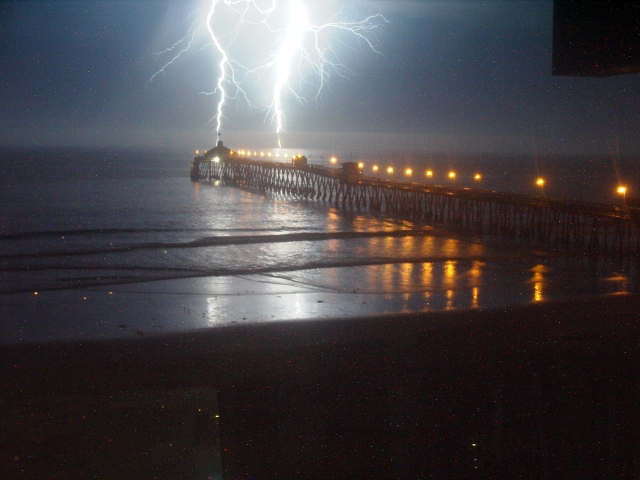
What a great picture!
<*}}}}}}}}}>< — Are there still some big fish around the pier? I guess the answer is yes! As reported by several sources, a huge white seabass was taken at the end of the pier in October 2014. The fish appeared to be over 50 pounds and apparently it was taken on a live sardine being used as bait for a thresher shark. As reported on Oceanic Angler: “LONG-TIME I. B. PIER regular known simply as ‘Oyuki’ among locals recently hauled this monster white seabass on to Imperial Beach Pier. The big biscuit easily buried the 50-pound scale he attempted to weigh it on.”
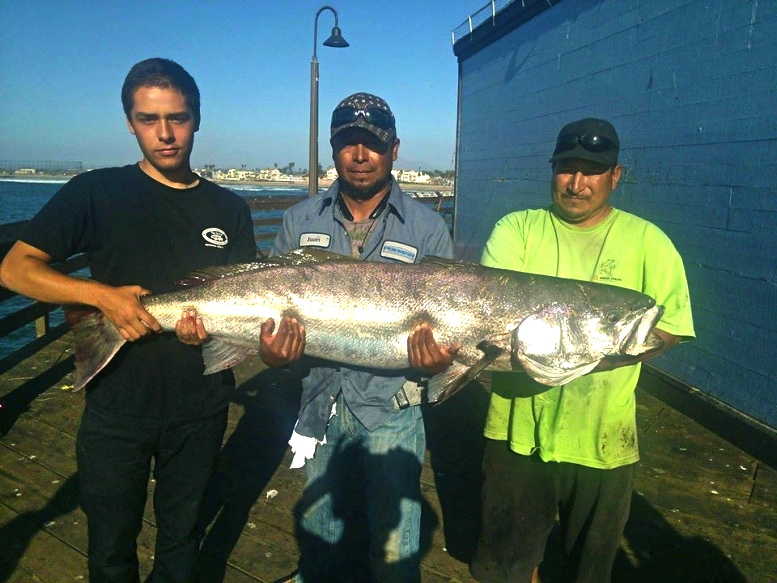
Picture of the white seabass (courtesy sdfish.com).
<*}}}}}}}}}>< — If the pier looks familiar it may because you saw the 2004 movie “Lords of Dogtown,” a movie based upon a fictionalized version of the 2001 documentary “Dogtown and Z-Boys.” The movie tried to recreate the look and feel of Venice Beach and its “Dogtown” in the ‘70s, a time when a group of surfers co-mingled their surfing and skateboard attitudes (and skills) to create the new skateboard culture. The I.B. Pier and surrounding area were used for six weeks in the production.

<*}}}}}}}}}>< — One of the traditions at this pier seems to be locals making hand-made bait rigs and offering them for sale. Almost every trip I’ve had to the pier has seen anglers asking if I am interested in buying the rigs, $3 each or two for $5, and they are good rigs, generally superior to the Sabiki rigs seen in most stores. You might want to try one.
<*}}}}}}}}}>< — Although it’s a non-fishing activity, every July sees the U.S. Open Sandcastle Competition held near the pier. The sculptures can be amazing and deserve a visit on your way to fishing, coming from fishing, or totally ignoring fishing (although you still have to visit the pier). It’s the nation’s largest such competition and upwards of 200,000 people come to see the artistic creations. Arrive early to avoid traffic/parking jams.
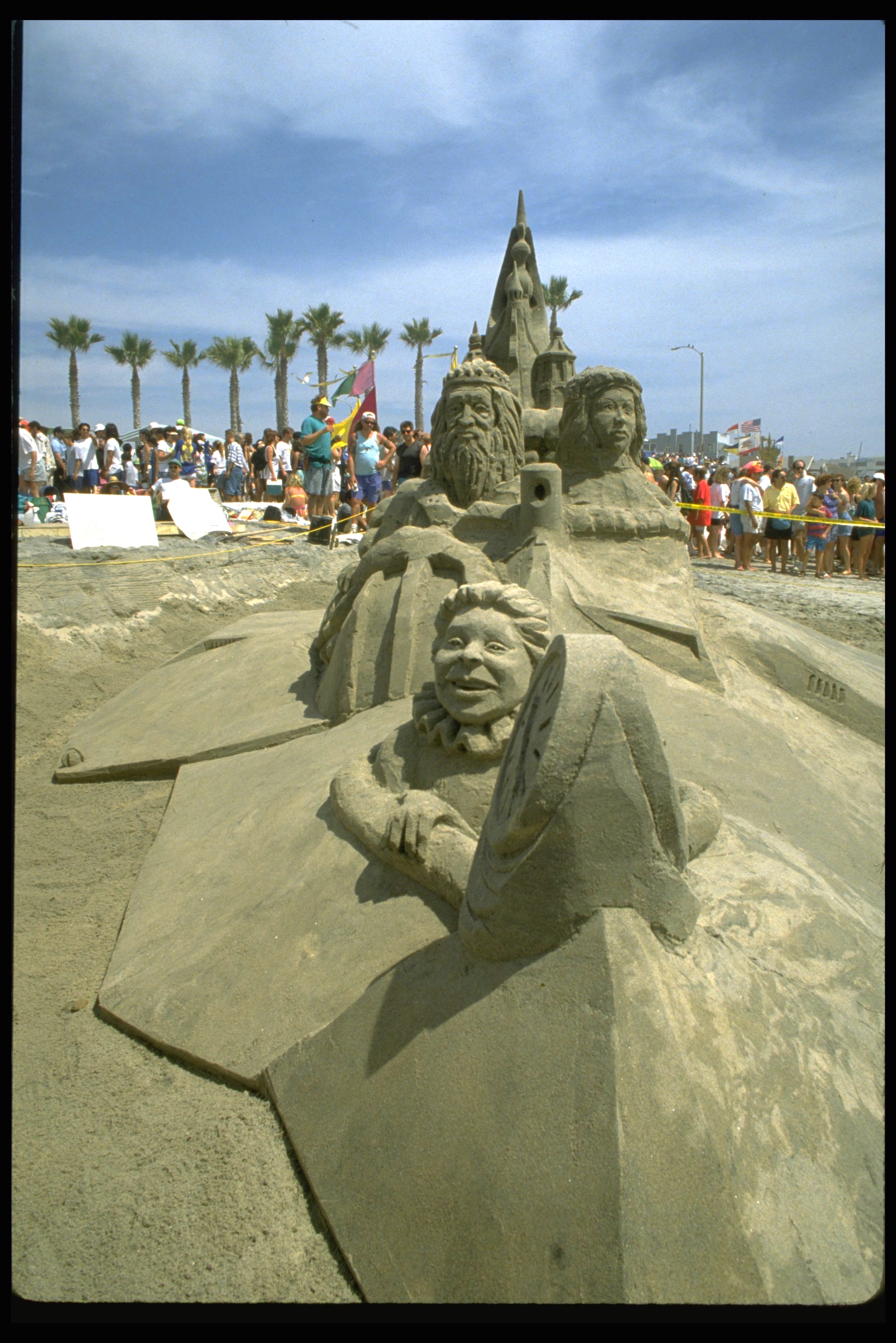
<*}}}}}}}}}>< — One of the sights you may notice from the pier is a large stadium that sits just 30 yards across the border with Mexico. The stadium is Tijuana’s last remaining bullring. Its official name is Plaza de Toros Monumental de Tijuana, its unofficial name is Plaza Monumental de Playas de Tijuana or Bullring by the Sea. It sits next to the beach, dates to 1960, and has a capacity of 21,000 spectators. It is Mexico’s second largest bullring. Supposedly it is “a stunning example of Post Modern Classical Architecture.”
<*}}}}}}}}}>< — This is one of the few piers where I witnessed anglers using bow and arrows to fish although that practice is now at an end (at least at IB). The anglers (if you can call them anglers) primarily shot halibut, corbina, guitarfish and large mullet in the inshore surf and were pretty successful. Opposition from surfers (who aren’t supposed to be near the pier anyway) and tourist-minded officials led to a prohibition against the practice. I thought I was the only person reporting this news (PFIC 1st and 2nd Ed.’s) until I saw the following newspaper story. I imagine a few more people knew about it after the story. BTW, should I tell him he’s using the pier totals from the 1992 PFIC that are outdated and that it’s corbina, not corvina?
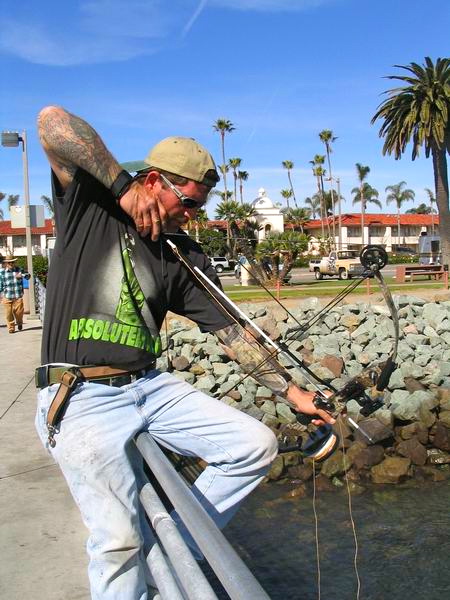
Bow fisherman — picture from the Shelter Island Pier but same person and bow
As Bowmen Hunt, Surfers Feel Like Targets
Imperial Beach, Calif., Nov. 13—There are 92 public piers along the California coast. Fishermen of all types inhabit them, but on only one, here in Imperial Beach, the last town before California succumbs to Mexico, is hunting fish with bow and arrow allowed.
On most days and nights, a handful of bow fishermen take up stations on the 1,500-foot-long pier, staring down with arrows ready for the telltale shadow or flash of scales of the corvina, or white sea bass, their most prized prey.
The ocean currents occasionally bring swimmers and surfers within the bowfishermen’s range, setting off angry confrontations, although no humans have yet been impaled. But Imperial Beach officials, reflecting the town’s rough-and-tumble character, have so far refused to ban the sport despite repeated protests from surfers and lifeguards.
Although the prime corvina feeding season had passed, Blake Jacobson was out recently with his bow watching for whatever might swim among the pilings. A school of mullet might occasionally pass, or a shovelnose shark, a stingray or a confused salmon too close to shore.
“Give me a big, fat, slow dumb guy, that’s what I’m looking for,” Mr. Jacobson said, his gaze never lifting from the water. His friends call him Blake the Caveman, and it is not meant as an insult. His hands are thick with calluses, his legs covered in scabs and bruises. He wears a torn black tank top with a tarnished silver fishhook necklace around his sun-reddened neck. His face looks as if his beard got the better of his razor some days earlier. He makes a living as a hand on an sport fishing boat, using traditional tackle.
On this day, he is wielding a compound hunting bow, modified with an open spool holding 350 yards of 100-pound-test monofilament. The arrow attached to the line leaves the bow at 300 feet per second, and if a fish happens into its trajectory, the tip will run right through it unless deflected by fin or bone.
The presence of these weapons on the public pier makes some people uncomfortable in this rather threadbare beach town. The waters on both sides of the pier are popular with swimmers, surfers and boogie-boarders, except when an inconvenient current brings sewage and runoff from the mouth of the Tijuana River down the coast.
The bow fishermen are not supposed to aim more than 20 feet from the pier, but they consider their target zone to extend about 30 yards from it because, they say, they need the extra room to get a clean angle. Surfers occasionally find themselves staring up at a hunting arrow.
“Last week I had to yell at a guy who had his bow pointed right at me,” said Serge Dedina, a surfer and former lifeguard here. Mr. Dedina said the bow fishermen were a belligerent lot, with little concern for public safety. He has complained to lifeguards and police, but little has been done, he said. “People in this town are terrified of these guys,” said Mr. Dedina, who asked. “Would you let a guy with a gun hunt on a Little League field?” he asked. “Someone’s going to get shot.”
Bow fishing is popular in the upper Midwest and the South. Most states limit the take to rough fish like carp, gar, suckers and other bottom-feeders. Bow fishing has encountered opposition in many places, particularly among other recreational users of the waters in which it is practiced, said Mark Ellenberg, president of the Bowfishing Association of America, which has about 500 members. “People go kind of crazy when they see us pointing arrows,” Mr. Ellenberg said. “I call it the tree-hugger factor.” He said some accidents had occurred, most involving bow fishermen shooting other bow fishermen. “For the most part,” he said, “it’s pretty safe.”
Imperial Beach tried to ban bow fishing five years ago, but the fishermen—a boisterous group of about 20 devotees—persuaded officials to let them continue under a licensing system. The city now requires bow fishermen to take a two-hour safety course for a permit. Bow fishing is not allowed during prime beach hours in the summer, but there are no limits the rest of the year.
“There was a group that was going around trying to get rid of it, like business owners and surfers who said that at nighttime there’s some dangerous people out there,” said Jeff Cox, a plumber who is considered the unofficial leader of the bowmen. “I’ve seen no injuries in my 21 years. And, listen, this town needs every bit of help it can get, especially because of the sewage spills from Mexico.”
Imperial Beach’s status as the only place in California permitting bow fishing from a pier is a peculiar distinction for an unusual town. It advertises itself as “the southwesternmost city in the continental United States,” and it has been the end of the line for drifters and small dreamers. In the Depression, thousands of refugees from the Dust Bowl settled here because land was cheaper than elsewhere on the California coast and work was available on the nearby farms and citrus groves. Only five miles from Tijuana and Baja California, Imperial Beach retains some frontier flavor.
“It’s kind of a blue-collar town with a hard-core element of people who really don’t like surfers,” said Mr. Dedina, who grew up in Imperial Beach and who runs a small environmental organization called Wildcoast. “A lot of people identify with the bowhunters.” Despite sporadic efforts to spruce up the place, Imperial Beach, population 27,500, remains a poor cousin of more gentrified Southern California beach communities like Newport Beach, Huntington Beach and Santa Monica. None of those places allow bow fishing from their piers.
Lifeguards have had run-ins with the bow fishermen, but no one has been arrested, said David Ott, who is in charge of public safety and is deputy city manager for Imperial Beach. Mr. Ott acknowledged some “inherent incompatibilities” between the recreational use of the waters and people with lethal weapons shooting into the surf. But he said he was supporting and enforcing the compromise with the bow fishermen.
Mr. Jacobson, about to give up the hunt after two fruitless hours peering into the empty ocean, said he had heard about problems between surfers and bow fishermen, but that things had been better lately. “Everybody has really stuck to the safety rules this summer,” he said. “There have been no accidents, no close calls, even. It’s very clear that you’re looking for fish, not a surfer.” Doesn’t really sound like my kind of thing, since impaling a fish with an arrow kind of obviates the option to practice catch and release. More like “shoot ‘n haul.”
—John M. Broder, New York Times, November 19, 2002
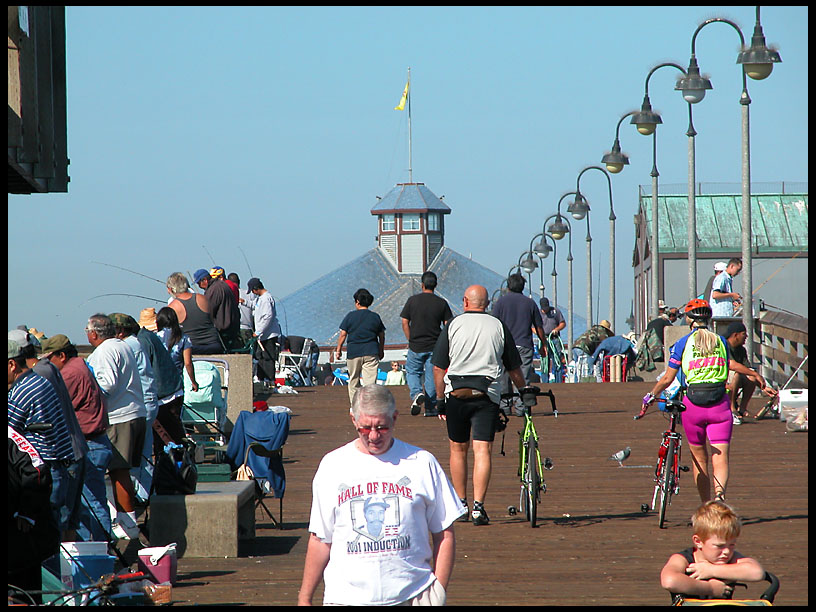
Bow fishing banned from city’s pier, shore
Imperial Beach—For decades Imperial Beach has been home to a subculture of sportsmen who like to hunt fish with bows and arrows. But within a month they will become another part of the city’s colorful history. The City Council passed an ordinance last week banning bow fishing from the pier or shore. It will take effect in 30 days. It was the fourth time in 15 years that the city tackled the issue of whether those who used steel-tipped arrows and those in the water could coexist at the municipal pier.
Each time the bow fishermen prevailed by convincing the council their pastime was safe. But now, with tourism and beach crowds increasing, council members unanimously felt bow fishing had to stop. Two bow fishermen came to the council to plead their case one last time. Bobby Hart, who was armed with petitions, complained that it seemed the wishes of the surfers took precedence over those of the fishermen. Mayor Diane Rose disagreed. “It isn’t all about the surfers,” she said. “For me, it’s all about the tourists who are coming to our beach and the safety of so many people. Hart said the council misunderstood the technical side of the sport, and said the fish are hunted at close range with arrows fired no more than 10 feet off the side of the pier. Surfers and swimmers are supposed to stay clear of the pier for 20 feet on either side but don’t always follow the guidelines.
Tom Wallace, a former lifeguard and avid bow fisherman, said there have been no documented accidents statewide related to bow fishing dating to 1994. He said many other recreational activities, including swimming, are much more hazardous and are not banned. Serge Dedina, also a former lifeguard and the director of an environmental organization in town, applauded the council’s action. “Basically, my kids can go out in the water and not worry about being shot by a bow-and-arrow fisherman,” he said. The city last tried to ban bow fishing from the pier in the summer of 1998. Under organized pressure from the bow-fishing community, council members relented and allowed the practice to continue, with restrictions. Bow fishermen were required to pass a safety course and obtain a certificate, and were prohibited from fishing during the daytime in the summer.
But, the council members said, the beach crowds have increased too much to let bow fishing continue. A city staff report concluded there were approximately 1.5 million visitors to the Imperial Beach shore in 1998. This year the city anticipates 2.5 million beach-goers. “Six years ago we did try really hard to find a compromise to allow the sport to continue,” Councilwoman Mayda Winter said. “But I just don’t see how you can mix a lethal weapon and large groups of tourists. That was then, this is now. Things have changed.”
—Leslie Wolf Branscomb, San Diego Union-Tribune, June 29, 2003
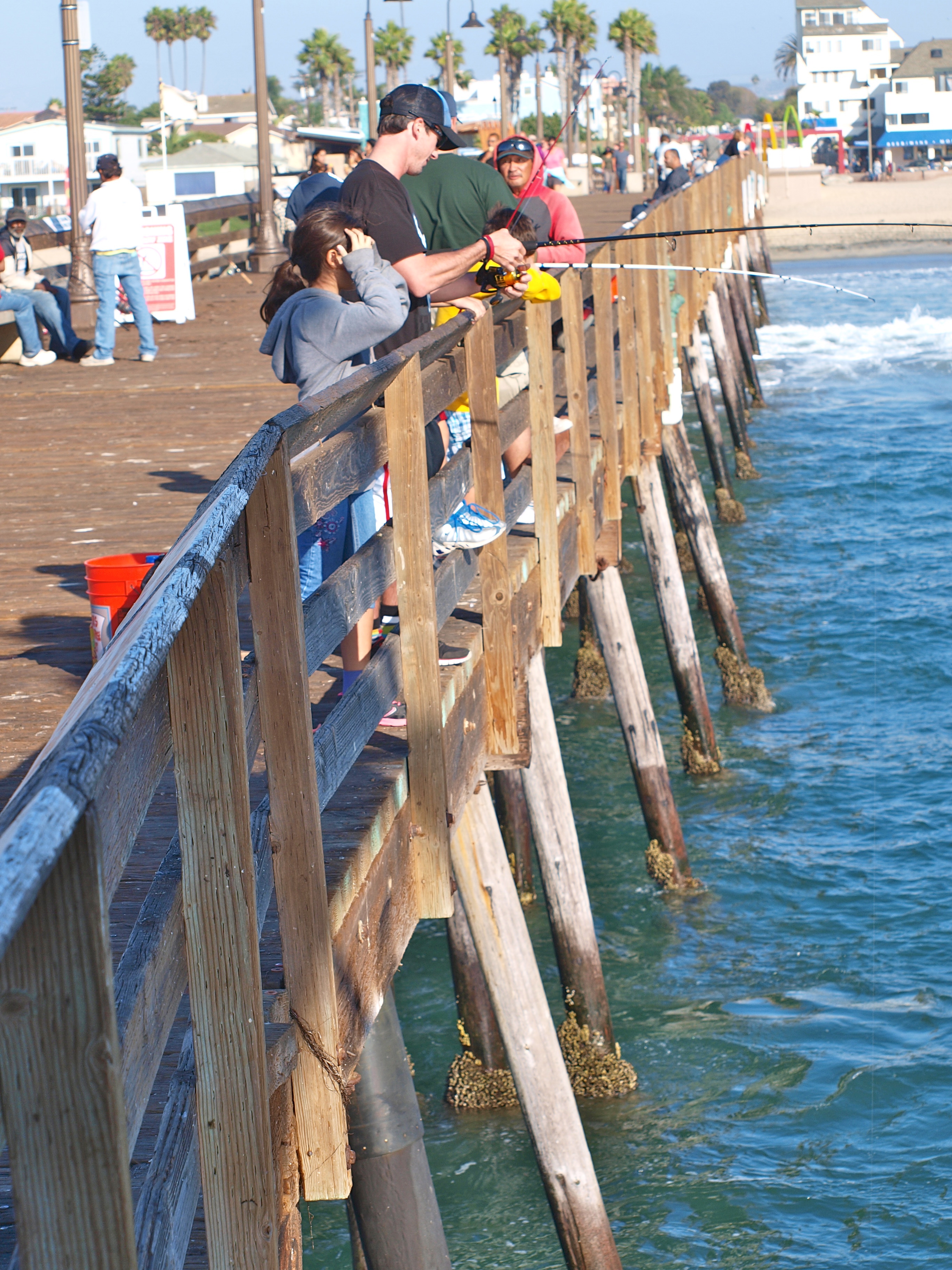
<*}}}}}}}}}>< — Some information that you may want to heed.
SDSU Study Detects Harmful Viruses in Local Coastal Waters
As a potentially wet El Nino winter looms on the horizon, new research from San Diego State University shows the health dangers from contaminated coastal waters after rain go beyond bacterial infections.
A new study by SDSU public health professor Rick Gersberg shows that after rainfall, coastal waters near the U.S.-Mexico border almost always harbor harmful viruses, in addition to the bacteria that are usually measured to detect health threats. The study is published in this month’s issue of Applied and Environmental Microbiology.
“t’s important to recognize the presence of the viruses, because it’s the viruses that actually pose the most significant public health risk, and viruses can be present long after the bacteria levels have subsided,” said Gersberg, head of the Division of Occupational and Environmental Health in SDSU’s Graduate School of Public Health.
Study Information: The study examined a total of 20 water samples taken between 2003 and 2005 at two sites: the surf zone at the mouth of the Tijuana River, and the surf zone near the Imperial Beach pier. Samples were taken in both wet and dry weather conditions. The goal was to quantify the levels of hepatitis A viral (HAV) particles and other indicators of fecal pollution in the vicinity of the U.S.-Mexico border.
“These locations were chosen because the mouth of the Tijuana River is the single largest source of pathogens to this area of ocean, and Imperial Beach is where the greatest amount of swimming and surfing is done in this area,” Gersberg said. “Until now, relatively little was known regarding the levels of human enteric viruses in this region.” Fourteen samples were taken immediately after a rain event of more than 0.5 centimeters or more in a 72-hour period during the wet season of late October through April. At Imperial Beach, HAV and enteroviruses were detected 79 and 93 percent of the time, respectively. At the Tijuana River mouth, HAV was detected 86 percent of the time, and enteroviruses were found in 100 percent of the samples.
Swimmers, Surfers Beware: Gersberg’s study is the first quantitative assessment of the statistical relationship between levels of HAV, enterovirus, E. coli and enterococci in marine waters. Gersberg said the high levels of HAV viruses measured during wet weather in San Diego can be attributed to the inadequate sewage collection infrastructure in that region. During the wet season, swimming in these locations is highly unadvisable within 72 hours after a rain event, Gersberg said. “Swimmers and surfers could experience anything from stomach cramping to a serious viral infection if they come in direct contact to this level of pollution,” Gersberg said. “It is also possible to contract the hepatitis A virus if the polluted water is ingested.”
Periods of Less Risk: The good news, Gersberg said, is that there appears to be little risk from viruses during dry periods. During the dry season of May through early October, six samples were collected at the Imperial Beach location. In all samples, the concentrations of the viruses were below the limit of detection. (Samples were not taken from the mouth of the Tijuana River during the dry period, because the flow of the Tijuana River at this time is negligible or even zero.)
“What this shows us is that the levels of bacteria and viruses during the rainy season don’t persist during the dry season,” Gersberg said. “So health-wise, it’s perfectly safe for swimmers and surfers to be in the water in these locations when we do not have any rain.”
—Gina Speciale, San Diego State University NewsCenter, December 11, 2006
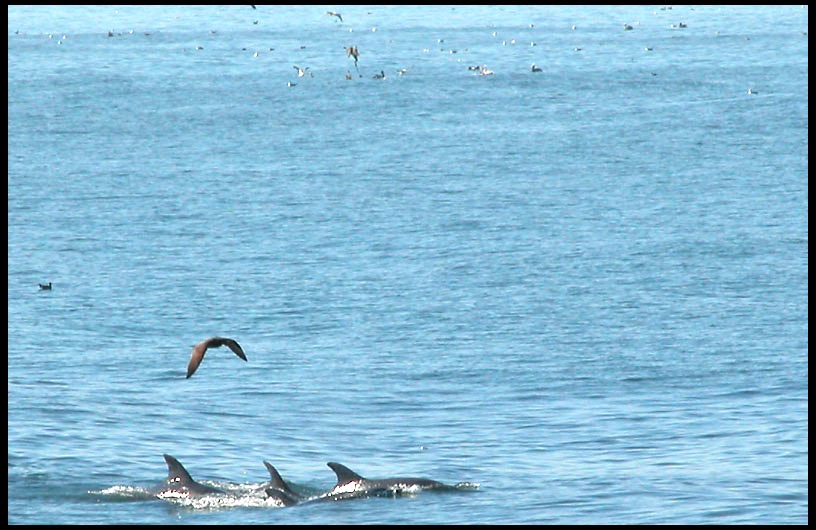
STOP! Unless you’re a real “pier rat” the following articles may be too long for you. Given that I am a “pier rat” they’re just right.
<*}}}}}}}}}>< — A long but very interesting article that does a great job giving the flavor of the pier as well as giving some insight into the thoughts and life of some Filipino pier rats. Filipinos make up a majority of anglers on several piers but all to often non-Filipinos hesitate to mix in and get to know their fellow anglers. It’s a real loss because the Filipino culture is a fascinating and colorful one and it helps explain their love of fishing and their love of eating fish (although in ways that may seem just a tad bit different). Get to know your fellow pier rats!
Pier group
There’s something about the hour before dawn at the pier. Out there in the dark, all you can feel is the ocean rollers hitting the long pylons beneath your feet, coming in to land after rolling their way across — who knows? — maybe the entire Pacific. Looking west, black nothing. No sea, no sky, and in the predawn fog, no stars. Just one great black spooky void. For all you know the great mythical sea monster from Baja might be opening his jaws in front of you at this instant, ready to chomp.
You hold onto the rail fast, even though it’s as cold as death. You try not to sway when each unseen roller below you strikes the pier. A kind of vertigo hits you at the sense of movement. It troubles your inner ear — and your inner sense of wellbeing. It makes you want to react, to pitch yourself forward. It would be so easy to let go, to give in, to fly into the night, the ocean, the void…
“Ay! Huli!” The words come from 20 feet away. A whole string of words follows. It sounds like Tagalog, the Philippine language. “May na huli akong! Malaki kabayan!” It’s not until later that I’m told this means something like, “A catch! I have a big catch, countrymen!” A little buzz of voices ripples out. The man who called out the first word, “huli!” — catch! — is shouting as he fights a mighty battle with an unseen force from below. I move along the rail toward the sounds. One word keeps coming up: “pating!” — shark. Now I can make out the shadow of a small man with a big pole that’s bent and twitching. Other shadows have gathered around, friends offering a string of advice. The voices rise to yells when the line screams out and the pole seems to leap from the man’s hands.
Suddenly it’s slack. Silence. Then shouts. They must be telling him to wind in. He starts frantically reeling, and there’s another jerk. He fiddles to release the catch on his reel, but the line twangs taut. He yells. In the graying light I see the silhouette of a knife blade swiping. The fisherman falls back. The end of his line dangles uselessly from his straight rod. For the first time he sees me. “Too big,” he says in English. “Too big.”
This fall morning, months later, in broad daylight, IB pier looks more prosaic. The waves are as huge as they were on that summer night. They sweep along like logs under a carpet, sending a shudder through the pier’s timbers. And I hear those words again. “Ay! Huli!” Except this time it’s an old woman in a huge, wide-brimmed straw hat held down by a scarf tied under her chin. She’s just tall enough to see over the wooden railing. She reels in her line from the gray waters 20 feet below and brings up a five-inch perch, wiggling over the rail. She maneuvers the hook out of its mouth and tosses it to flap in a white plastic bucket on top of a half-dozen other diamond shapes gasping away.
She catches the swinging line, leans over to the lower rail she’d been using to chop up mussel meat. She stabs a piece onto each of the two hooks, then drops it over the edge and swings it back out into the surf.
This is one of those fresh, foggy, cool mornings that braces you. Life is worth living. The pier is busy with fishing people, mostly Filipinos. They haul out their grocery carts filled with plastic buckets and pipes (to hold their rods vertically) and head for their favorite spots. Local drunks lean over the rails contemplating life, lifted after the day’s first beer. Down in the water the waves are immense, ocean-sized. Surfers ride in under the pier, despite the sign telling them to keep 150 feet away. “Back off!” one fisherman yells down to them. He wants to toss his line.
The beach end of the pier is the end to be on right now. It’s a rising tide, and the old lady says that’s when the anchovies come seeking food around the pier legs, and the mackerel are coming in after them. And the blue-topped bonita are following the warm waters in to feed on the mackerel. And the sand crabs are coming in with the tide to eat the detritus collected on the bottom over the last half-day. And the perch are coming in to feed on the crabs…But the warm waters of summer are long gone; pickings are leaner this morning. People, mostly women, are catching only perch. Not such a bad fate. “The perch love those sand crabs,” says David Dubert, one of the few men here — and one of the few Anglos. “Perch have a good set of teeth on them. They can nibble through those shells, no problem. So when you eat a perch, you’re getting two meals for the price of one.”
David Dubert knows about food values: he’s lean, short, muscled, 52, and runs a Pizza Hut not far north of here. Today, as on most of his off-days, he’s strolling down the pier with a brown-bag beer in hand. He’s so mad that IB authorities are about to make this illegal, he’s considering leaving town — after 40 years. But mostly he’s mad that more people don’t live the pier life as fully as the Filipinos do. “I’ve been fishing off the pier for all this time,” he says. “I’ve seen fish get fewer and most Americans give up on them. But not these people. I’ll tell you, it was these wonderful, generous people — the Filipinos — who taught me everything I know about saltwater fishing. I came from the Great Lakes. Freshwater fisherman. These people, they know the life that’s going on underneath, what the fish are doing, who’s eating who. Just look up here: 80 percent Filipino! That’s because they use this pier. This is not sport for them, this is food-hunting. You can just about live without ever visiting a supermarket from what you can catch on this pier. The fresh air, the quiet — this is a social center, but see? Most of them are old. They were brought up in the Philippines, on the fish they had there. They had to learn a whole new ball game here. And I got it all from them. Others could learn from them, too.” A man walks by and tosses his Crown Cola can into a trash bin. He takes a few steps, then turns back. He reaches down for the can. “Sorry, Honorata, I forgot.” The little lady who’s been catching the perch laughs as he leans down and puts his can into one of the three buckets she has on her cart.
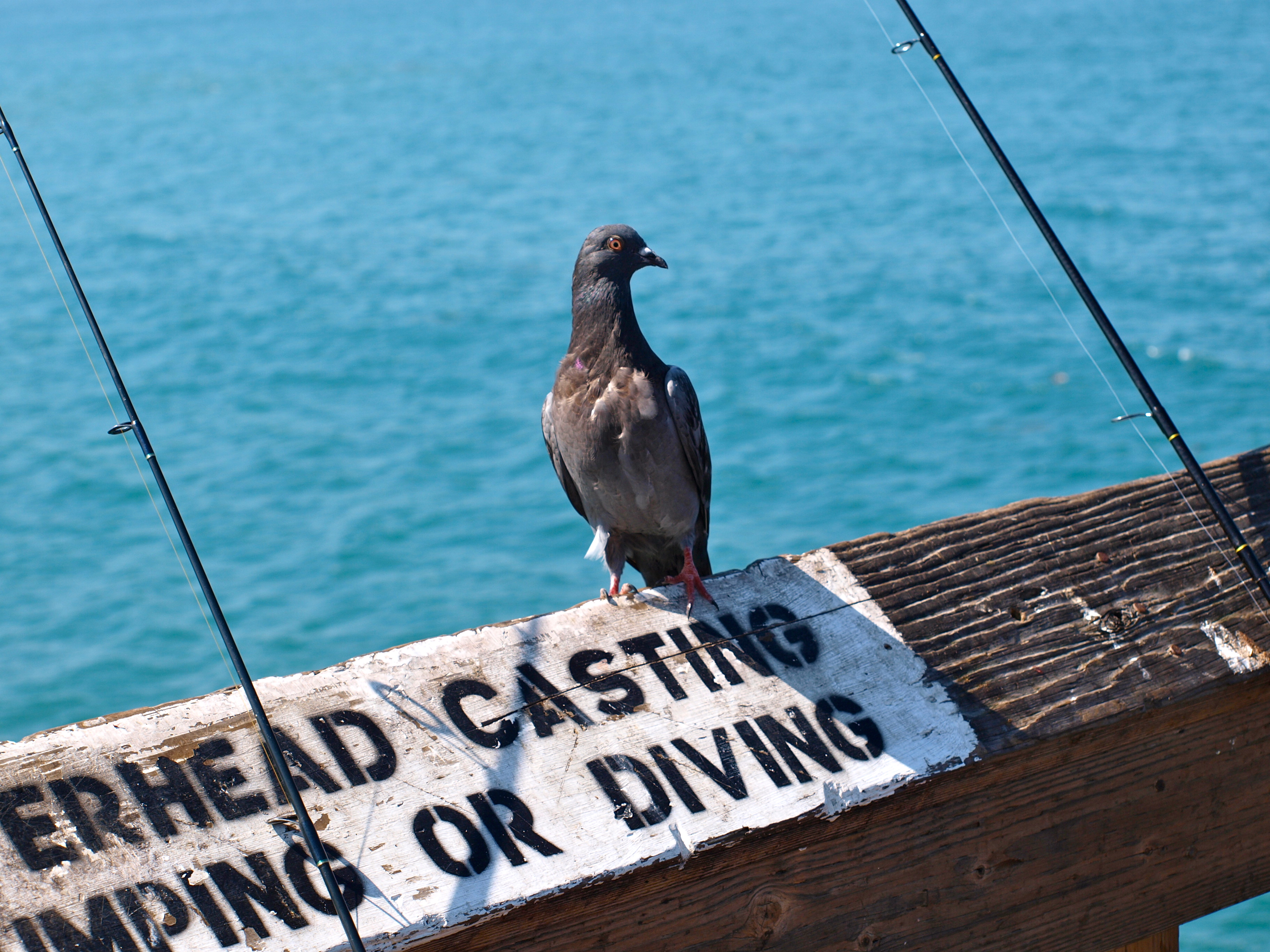
“Nothing wasted, right?” Honorata Asilo Magsino, known to everyone by her Tagalog name, Aling Atang, has been fishing right on this spot for 13 years. She’s 75, and before 1982, she was in a wheelchair. She couldn’t go anywhere on her own. She was depressed, stuck at home — and home wasn’t even in the Philippines. So one day she got up, hobbled down to the 933 bus, and came to the pier. She hasn’t missed a day since. She leans on the railing all day long, from nine till four, when she catches the bus back home. “This has saved my life,” she says. “I eat fish, good for my arthritis. The fresh air, the company, the excitement catching the fish. And now I am useful; I have something to give my family to eat, too. That’s why I come.”
I ask her what she’s going to do with these fish. “I will dry them,” she says. “For tuyo.” Tuyo is a breakfast. “Rice and fish,” she says. “Poor people in the Philippines have rice and fish — three times a day, if they’re lucky. They eat less, but they are healthier than people here. They don’t like sweet things, except for fruit. And making tuyo is very easy.”
Tuyo or Daing: Catch a fish (say, perch or mackerel); Slit it open (if it’s mackerel, down the backbone); Clean, sprinkle with salt, pepper, soy, vinegar; Lay out in the sun, leave two to eight hours (depending on the sun’s strength); Fry in skillet Creates a crispy fried fish that lasts a good, long time; Break up and mix with rice (or scrambled eggs); Add vinegar sauce (vinegar, chopped onions, and garlic).
We’re further out now, on the “T” section of the pier, the part with the cold metal rails. Rita is standing with her pole against the rails. She has the line in her hand, and as she watches the sky and the waves, her arm is lifting and lowering, up and down, up and down. She has a can of bait: anchovies. “I bought it,” she says, as though she’s done a terrible thing. “$2.41. Commercial bait, fishing pole — I’m fishing the American way.”
Well, not quite. The lifting and lowering is part of the technique for catching surface fish like Spanish mackerel or anchovies. Like humans or ostriches, the mackerel’s wide-angle eyes are attracted to shiny, moving objects. “Mackerel are top-fish. They’re hunting, they bite. Not like bottom fish, which have lips and suck, looking for dead stuff or leftovers,” says Rita.
Today she’s interested in opal-eye perch and buttermouth, but she’s here seven to eight hours every day. If it looks like a job, she says it’s one she loves. She’s a grandmother (though she looks too young, as Filipinas often do). Today her three grandchildren are with her so her daughter can work. Together they usually catch enough to make a couple of meals. One of her favorites is pinakbet.
Pinakbet: Chop up eggplant, bitter melon, squash, okra, oriental beans (string beans); Add sliced onions and garlic; Toss into skillet with bit of oil, sauté; Slice (any) fish, cook ten minutes; Add bago-ong (fish or shrimp sauce); Eat with rice.
Rita says she didn’t actually start fishing till she came to the States. But she has a fishing background. “We lived over the sea. In a stilt house, a nipa hut. Poor people mostly live on the coast. They can’t afford land, so they live out over the water,” she says. “I never fished. The men did that, from boats, with nets. But we ate fish. Breakfast, lunch, dinner. We had a garden plot on the land behind. We grew vegetables, poultry, kept goats and a cow. “Sometimes the only thing we bought was rice. Fish was everyday. Meat was for special occasions.”
Not far away a young Filipino boy is hauling on a rope. I look over. He has a four-fluke grappling hook down at water level. He swings it against one of the pier’s pylons. It scrunches into a colony of black mussels and rips off a clump of the smaller, younger ones on top. “See?” says David. “Free bait. It’s the same for anchovies. Anchovies make great bait or great food. People here taught me what they call ‘The Lucky Joe.’ They set seven to eight tiny hooks on a very fine line, put a small weight at the end, and tie tiny feathers to each hook. No bait. You drop the line in just below the surface, where the anchovies swim, and just keep that line moving up and down. Pretty soon you’ll be catching eight at a time. Catch about 300 and you’ve got a great meal. Just break their heads off…”
“No…” says Rita firmly. “You Americans don’t like fish heads, but that’s the best part of them! My grandmother always told me you get smarter if you eat the head. Because that’s where the brains are. At my home, when the fish came on the table everybody wanted the head. “Any size fish, it was the tail nobody wanted. You just take the head and suck out the brain. And the eyes! They taste great, and they’re full of protein, too.”
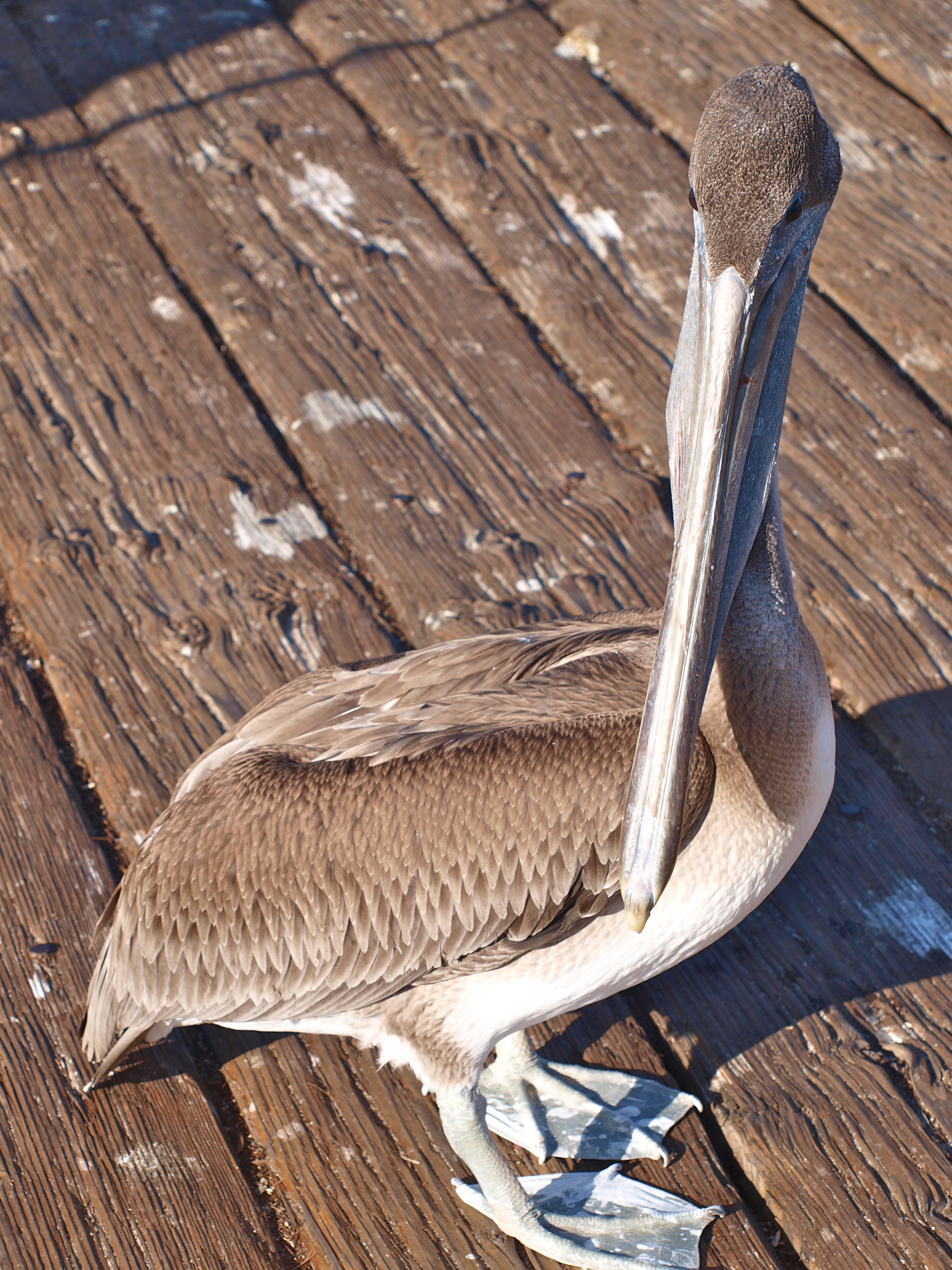
David shakes his head. “Can’t do it,” he says. “But I can,” says David’s Filipina wife, Laura, who has turned up. “When David’s away, I ask my girlfriends to come round and bring some fish heads. Especially bottom fish, like croakers, or sand bass, because they have lips! The lips are the nicest part of all. So tasty! Americans miss so much! David, he only eats fillets of fish.”
“Well it’s better than meat, hamburgers,” says Edith, a Filipina RN and Rita’s friend. “This food is so much healthier. I tell my patients, it’s good for high blood pressure, for cardiovascular health.” “And the bones of the smaller fishes, like perch,” says Rita, her arm still moving slowly up and down like an oil rig. “They’re so good for you. And you can fry them and eat them whole.” “Or you can put them with what we call deninding,” says Laura.
Deninding: Fry fish; Boil water; Add onions, eggplant, bitter melon; Add jute leaves, horseradish leaves (buy from Filipino stores in National City or Chula Vista); Mix in two tablespoons of fish sauce (bago-ong); Simmer till water evaporates; Flop fish on top; Eat with rice.
A boy and his dad come up with a brown paper bag. Dad tips an angry, brown-red fish onto the deck. “What is it?” he asks. “Don’t touch it!” says Rita. “It’s a sculpin. It has poison quills.” “I’ve been stuck by these ten times,” says David. “My whole hand swelled to twice the size. I got headaches. My stomach hurt. It lasted hours. Last time they had to bring the ambulance.” “You’ve got to be real careful,” says Rita. “But if you cut the two spines off behind its eyes, you can eat it. But they take a long time to die.”
The father pushes the bag back around the fish and takes it away. On the other side of the pier, an Anglo man has a crossbow with a fishing line attached. He’s trying to unravel the line so it doesn’t take him with it when he shoots it out. Nearby, fishing on her own, lifting and lowering her line by hand with hypnotic regularity, Serafía Castillo, who says she’s 66, is catching anchovies for drying and sending to her relatives in Arizona. “Best time for the bigger ones,” she says, “is when the tide is coming in, when the moon is full.”
She rubs her tummy. “I can’t eat mackerel or barracuda any more. My body’s no good. My stomach gets tight when I eat mackerel. I found it harder and harder to move. So I have stopped eating oily fish. Now I eat other fish that swim at the top, like perch. I think I feel a little better.”
“Knowing where to catch what, that’s the thing,” says David. “You’ve got top-swimmers, bottom-swimmers, and scavengers. It depends on the time of year — and June, July, August are the best months because the waters are warmest. What you have to decide before you put your hook in is which you’re going for — top, bottom, or scavenger.”
IB’s top-water fish are anchovies, sardine, perch, queenfish, Spanish mackerel, and bonita. The bottom-fish that come around the pier are croaker, sculpin, sand bass, a few small catfish, flounder, halibut, the occasional lobster, and crabs.
“Then there are the scavengers. Best time for the scavengers is nighttime,” says David. “Ten p.m. to six in the morning. The tiger shark, sand shark, stingray — they’re all fighters. You’ve got to have 100-pound heavy line. You’ve got to be prepared to have large reels and poles. And you’ve got to be prepared to be out all night. They can reach 40 to 50 pounds.” I immediately think back to that predawn morning last summer…It might have been a tiger shark.
Serafía is telling me that one of the great delicacies is the head of a tiger shark, baked and stuffed with vegetables and spices. “Not many are caught,” she says. “They fight so hard.” She jerks her hand at last and hauls up a shimmering pearl-string of anchovies.
I ask Serafía if she isn’t worried about the sewer pollution around here. Maybe that’s what’s bothering her stomach. “I’ve seen the insides of fish here and at other piers,” she says. “They are whiter and taste better here. I think this water is the cleanest. Better than Shelter Island. Better than Ocean Beach.”
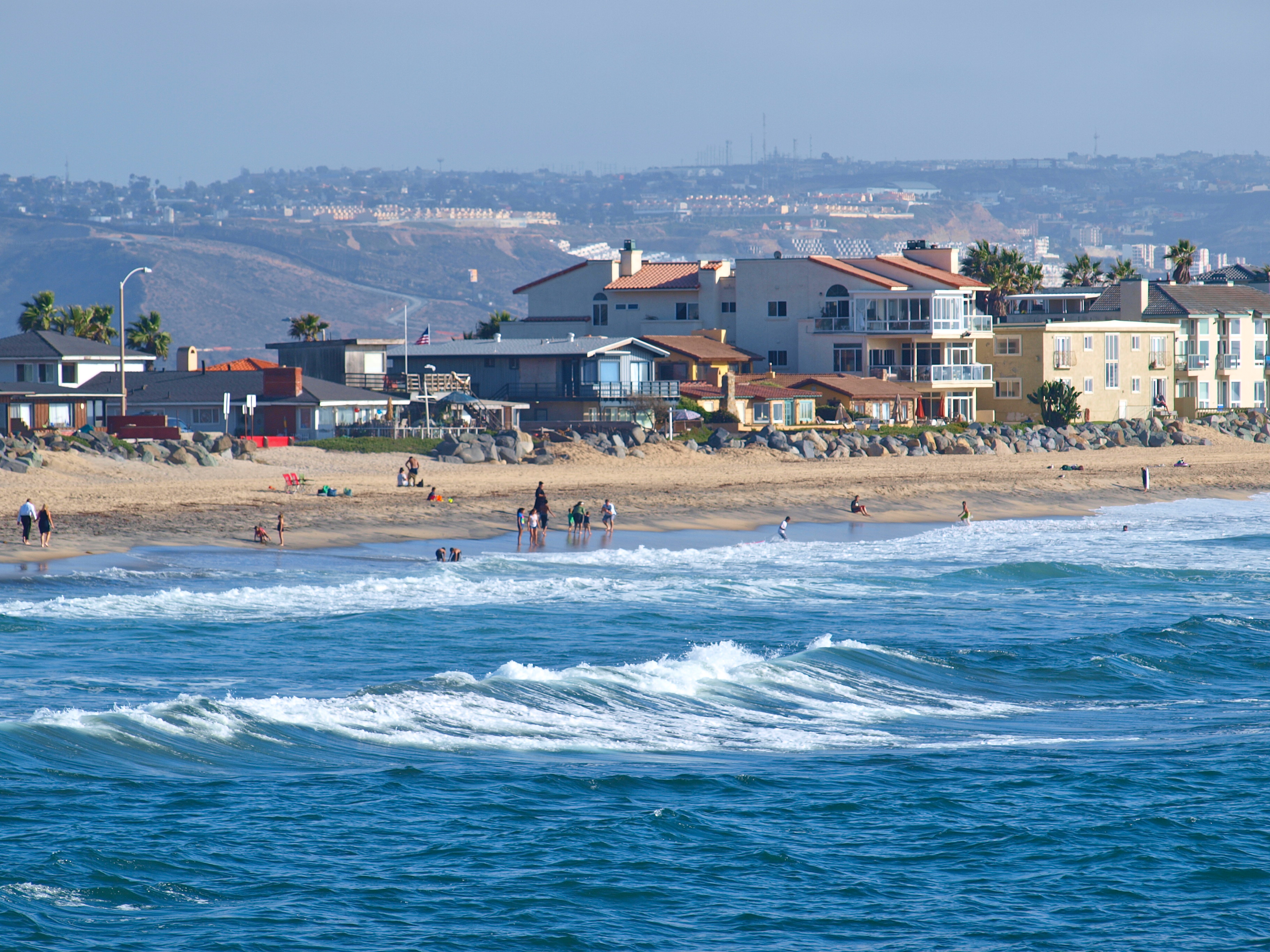
Imperial Beach shoreline with the hills of Tijuana, Mexico in the distance
A couple of days later I happen to be in Ocean Beach. I can’t resist moseying out on its concrete pier to see if the story is the same here.
“Peas. I use peas for bait,” says Al Gil, a middle-aged Filipino I find halfway out on the pier. The atmosphere’s different here than in IB The ocean is more…roistering. There’s more arching surf, smashing in front of cliffs near the beach, and the place is crisscrossed with pelicans making low cruises right over your head in dignified, determined lines of 12. In the water, ranks of surfers, of course, and regular clumps of sea lions bouncing out of the water, looking around, then confidently rolling back under.
On this pier there seem to be more Koreans and Vietnamese fishermen than Filipinos. And more nonfishermen with hard liquor bottles lounging in the postfog sunshine giggling at the “Crime Watch” column from the Union-Tribune.
I came across Al next to where a Filipino family of three was fishing, the son dropping a large parachute net in between his parents, catching bait, hauling up maybe a dozen anchovies in each lift. His bucket was already half full.
The peas must be working: Al has three or four perch in a plastic shopping bag. “I give them to the neighbors,” he says. “They love it, and I feel good. We Filipinos, we don’t like processed food. We like it fresh. Vegetables, fish…” He’s hauling up a fish, a queenfish, about six inches long. But it slips as he takes it off the hook. It bounces once on the rail and dives down to smack into the water.
“Have a great life!” Al yells after it. “Those ones are kind of strong-tasting anyway,” he says. “Fishy aftertaste. Not that that’s a problem. What we do is, first we cut them right down here.” He draws a line down my backbone. “I put in garlic and ginger and salt and pepper. Then I put the fish in some vinegar and the whole thing goes into the fridge for 30 minutes, and that fishy aftertaste and smell is gone.”
We stand leaning on the rail, watching the sea lions cavort. I can’t help feeling it’s not just the fish that bring so many Filipinos down to the ocean. “I think a lot do find it a kind of bridge with the old life,” Al says. “Me, I fish because it’s better than dying in front of a TV set.”
He says he’s grateful for the health system in the US; he looks like a man who might need it. “It’s good, great for medicine and doctors here,” he says. Then he stands up straight. “But for happiness — there! The Philippines. At night sometimes I think of the smell of the mangoes, of the fresh pandec in the morning. The pandec man comes around the streets at 4:00 a.m. on his bicycle with a big, shiny, covered can at the back. He hoots his hooter and calls out, ‘Pandec!’ and the pandec — round bread — is still hot. Fresh! It’s great with eggs. And then there’s salavat. A great breakfast drink.”
Salavat: Heat water; Cut up and squeeze ginger root into the boiling water;
Add brown sugar Great for soothing throat, smoothing out voice in morning “And then we have a cigarette!” Al says, laughing. “If I went home tomorrow, my children would all be there. They would take their papa straight home. We’d sit down to a big round table, and they’d serve up my favorite dish: baked bass.”
Baked Bass: Clean a sea bass; Steam in clay pot; Splash on mayonnaise, tomatoes, onions, garlic; Steam a little more to absorb flavors; Serve with rice.
“And of course we’d have pancit — noodles. On any occasion — like Christmas, birthdays, homecomings — we must have noodles because they symbolize long life. Every home must have nice, long noodles ready.
We’d pray together and thank the Lord for the food — and I’d know I could stay there till I died. They wouldn’t send me anywhere. That’s our way. And the fiestas, when each house on a street cooks something different and you go from house to house eating chicken, fish, fruits. Yes, I think of these things. This country is very advanced, but some things it lacks. I miss them.”
“I would go back, too,” says Laura, a few days later in IB “If we have enough money, we’ll go, to stay over there. It’s a nice living over there. Very nice life, as long as you have enough money. That’s what I told David. My family has a cottage near the sea. The only problem is, David would want to fish.”
Problem? “I won’t let him go fishing if we go over there. It’s embarrassing! There’s no American people doing things like that back home. My brother won’t let him. He’s putting me down if he does something like that. Fishing? There are no Americans go fishing over there! Only Filipino people.”
—Bill Manson, San Diego Reader, November 30, 1995
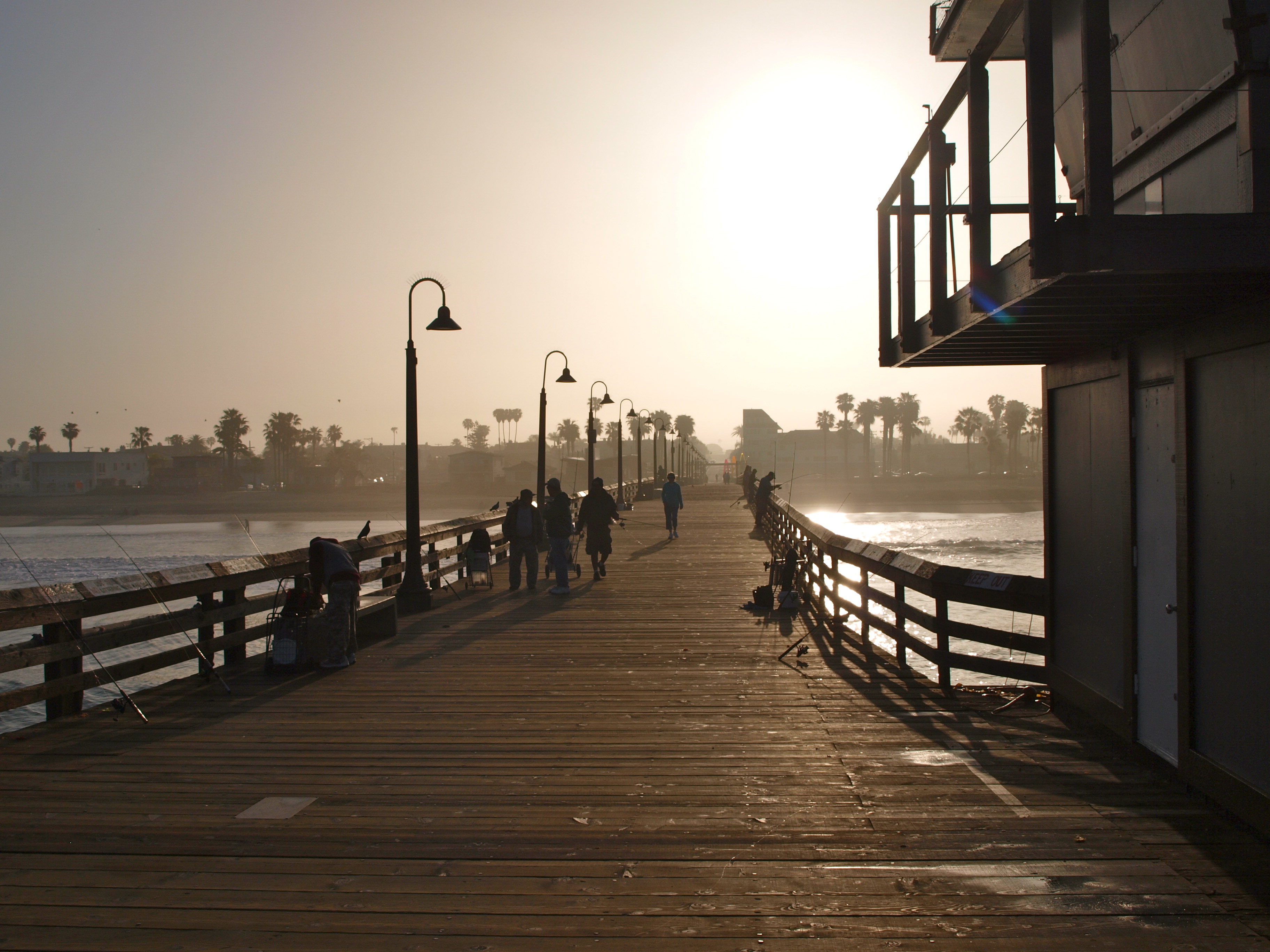
<*}}}}}}}}}>< — Here’s an article about California piers, not just Imperial Beach but all the piers along the coast—starting with Imperial Beach. And, it even includes a few kind words about yours truly.
California’s piers: Enjoy their primal allure
These romantic shoreline structures scattered up and down the state, some dating well into the 19th century, have sights and sounds all their own.
How was that little vacation you took? You remember. It cost you almost nothing, it burned some calories (or, after that ice cream cone, added a few) and briefly immersed you in quintessential California.
It was that walk on a pier, those structures that stretch out like a gateway into the Pacific. Perhaps we don’t think about them much, but they’re part of what has made California California: Piers (or wharfs as they were called in the mid-19th century) once were the primary way of moving food, cargo and travelers on and off sailing vessels. After having walked 75 of California’s finest piers in the last year and a half, I also found they were the best way to move…me.
During my jaunts up and down the coast, I skipped some of them. I didn’t do military piers (not open to the public); I eschewed commercial business piers (too dull). I ignored the un-touristed reaches of the San Francisco Bay, particularly leading back into the freshwater Sacramento Delta. And I blew off the state’s thousands of private and public boat docks (a pier has pilings, a dock has none), leaving those for some other pilgrim.
That still put me on long piers (some more than half a mile long), short piers (one only 75 feet), rickety old piers, new but sometimes boring concrete piers, solitary piers and piers jammed with fun seekers. From the end of the trim structure over Imperial Beach—from which you can see Mexico—to the charming harbor in Crescent City, which is almost to Oregon, piers increasingly seemed to me less utilitarian and more like inviting portals into the past and present.
Monterey had the first pier, which went in 1847. Then railroads began became the hot new mode of transportation, and soon train tracks were being installed near the piers to ferry goods up and down the coast. Next came the car, but most piers weren’t built to accommodate the auto. But real estate impresarios figured a way to bring newly mobile Californians to the shore by building “pleasure piers”— places bustling with dance pavilions, restaurants and arcade games. Sometimes that bait worked; sometimes it didn’t. You can see the ghosts of those failures even today.
Like the people who dreamed them, piers are perishable. Their decline can be slow, as wind and water chip away at them, or fast, brought to their knees by coastal storms, especially in the El Nino years of the ’80s and ’90s. Even steel and cement sometimes are no match for Mother Nature. For instance, the Aliso Creek Pier in South Laguna Beach, built in 1971, lasted barely 25 years before El Nino tore it apart in the late ’90s.
If our piers have a guardian angel it is the California Wildlife Conservation Board. The board was created to “administer capital outlays for wildlife conservation and related public recreation” and is now in its seventh decade of working with local cities and counties to fund construction of piers, and, more recently, coordinate their restoration.
Ken Jones, whose book “Pier Fishing in California” and website (www.pierfishing.com) are the definitive guides to the California structures, notes, “In the 1960s this group helped build or renovate 16 piers in the state. And in the 1980s, after the 1983 El Niño storms hit, they worked on 18.”
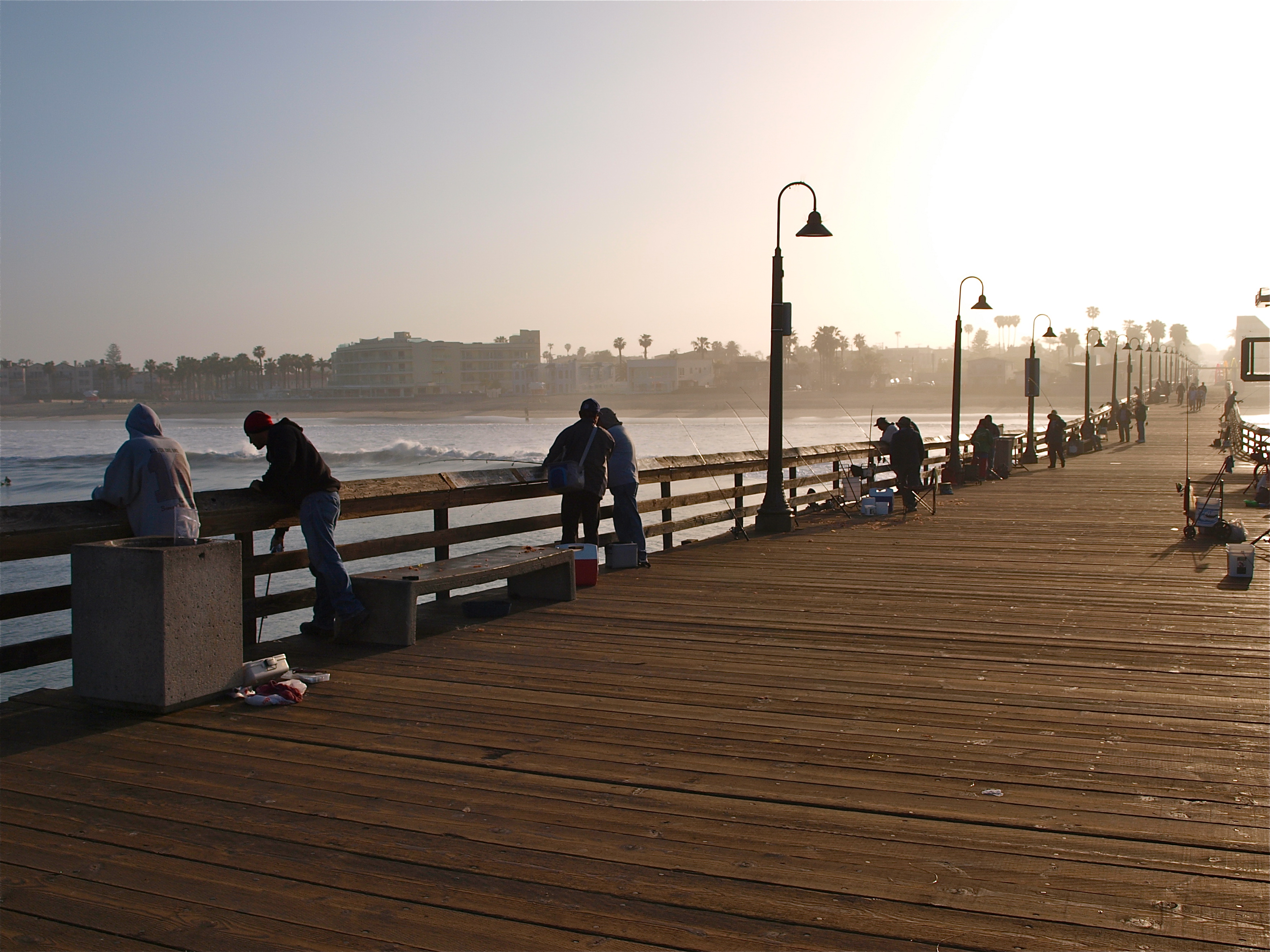
Jones, who loves to fish, specifically off piers, has been a self-described “pier rat” since 1962. (He says a true pier rat “leaves the pier cleaner” than when he arrived and helps unhook birds that get snarled up in man’s detritus.)
His favorites among all that he sampled (and he has sampled all of them): “Ventura Pier, with a beautiful sunset and those islands in the background, can be great.” And “The ‘B’ Street Pier in Crescent City—that is something.”
Momentarily less pier rat and more uncrowned poet laureate of California’s piers, Jones explains their primal allure. “For me, out there at night, so still except for waves splashing against the pilings, maybe some moonlight on the water…It’s simply a special moment and place to be in the world.”
I found Jones’ special moments and places aplenty during my own wanderings. (The highlights of each pier I visited can be found at latimes.com/piers.) They were, I realized, a sort of low-cost spa treatment.
They’re also a window into nature—bird and marine life and California’s life. As you meander out on a pier, you see, for a moment, a small portrait, each, by itself, interesting. But together, they paint a picture of a state where the riches are sometimes more psychic than sensational. Staring out to sea, listening to the waves, hearing the cry of a gull, I felt complete.
—Christopher Smith, Los Angeles Times, July 1, 2012
<*}}}}}}}}}>< — An interesting article from the early days of the pier.
Lee Chilson’s South Bay Scene
There is absolutely nothing like a sunny winter afternoon on the new fishing pier at Imperial Beach. The skies are clear, the wind is fresh and the water is ice blue. Screeching birds swoop down over the rolling water in search of food. Strollers move up and down the long expanse of the pier, looking into each bucket along the way to see what mysteries of the deep have been snatched from the water by fishermen.
Small boys form a line at the concession stand, are waited on, then scurry back to their waiting poles and munch potato chips or candy bars, patiently waiting for The Big One to take the bait.
A teenage girl steps up to the bait counter and orders “a bagful of barnacles,” but the young attendant just laughs and hands her what he knew her fisherman-father wanted: A bagful of clams.
The sun glistens on the water as the big waves thunder in under the pier and crash to the beach. A lone surfer, his board pointed to sea, wisely changes his mind, turns about and rides a wave back to the beach. “It’s too rough for surfing today,” one of the young experts says.
An older couple takes turns squinting through one of the two dime-deposit scopes and there are “ohs” and “ahs” as they scan the Coronado Islands, Point Loma and the San Diego skyline in the clear, bright sunlight.
Cars nearly fill the parking lot at the approach to the pier and an occasional fisherman hurries back to his car to drop more coins in the meter, lest he get a ticket for over-parking. Because the meters, like the rolling waves, never cease. They’re in operation 24 hours a day, every day.
On days like this the pier attracts fishing buffs of every age group. They come in pairs, threesomes and in family groups. Old men sit on the big benches, half asleep in the warm sun, their fishing poles beside them and the lines hanging limp into the deep water below. They look almost as if they were hoping the fish overlook their hooks and go bother someone else.
The grandmother-type is seated at a bench on the other side of the pier. She is alone, except for her big bag of lunch and a tackle box loaded with hooks, sinkers, lures and all the gear. She chats with everyone that passes by and you get the feeling she’s more there for the company than for the fishing.
A young man, obviously proud of his catch, is cleaning four medium size ocean perch at one of the sinks provided along the pier. He’s in no hurry to clean his fish and he stops his work as sightseers stop by to look at his four beauties.
A young mother hurries along the pier in a vain attempt to keep up to her young son. Then, on the way back, she has to pry him from each one of the convenient water fountains that line one side of the 1,200-foot long pier. And, as she nears the last one you hear her say to no one in particular, “I don’t know why they had to put so darn many of those things along the pier.”
The small family—man, wife, two youngsters and a baby in a stroller—make their way toward another bench. The little one is content with a bottle—at least temporarily. The father baits two lines, hands a pole to his wife and they settle down on the bench to fish as the two kids romp down the pier in search of adventure.
It’s cooling off now. The wind is stronger across the vastness of the Pacific and the sun is dipping lower in the sky. Heavy jackets are zipped up, hoods are pulled over heads and tied. Those less hardy reel in their lines, put away their gear and head for the parking lot and home. But the real fishermen stay.
The concession stand does a brisk upturn in hot chocolate and coffee as the sun drops all the way into the sea and a light fog rolls in to add a chill to the evening air. It gets darker, but fishermen—small boys, old men, the grandmother types and teenagers—stay. Then the row of vapor lamps sputter on along the north edge of the pier and along the T at the end. The lights cast new shadows and turn blue jeans to purple and ruddy faces into an eerie bluish color.
It’s damp now and rain threatens. An occasional drop or two falls and more fishermen round up their gear, reel in their lines and head for the warmth of their automobiles. But the next morning the skies will be clear again. The wind will be fresh and cool and the water will be ice blue. The sun will be back again and so will the screeching birds. And just as sure as the sun, the wind and the sea, the fishermen—all ages, all kinds—will be back too.
—Chula Vista Star-News, February 20, 1964
History Note. Prior to the Twentieth Century, this area was called South San Diego. Then, in 1908, the South San Diego Investment Company was formed. R.R. Morrison filed plans to subdivide the area and George Chaffey bought several parcels. His plan was to create a beach resort and retreat for those trying to escape the summertime heat in Imperial Valley, hence Imperial Beach. His plan was successful and the area became one of the many thriving resorts along California’s shores.
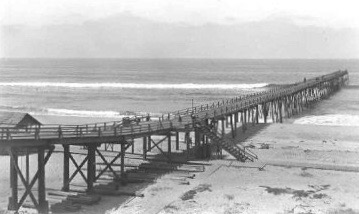
To stimulate real estate sales, the investment company organized the South San Diego and Imperial Railway Company in December of 1908. Passengers would sail on a ferry down from San Diego to a landing in the marsh where they would transfer onto a gas-powered car to take them to “beautiful Imperial Beach.”
In 1909 a boardwalk was built, as was a 500-foot-long pier at the foot of Date Street. The Imperial Beach Improvement Association built both and the two became the centers of beachfront activity. In 1912 the ferry ceased operation but direct electric inter-urban train service began from San Diego to Imperial Beach—an event that affected the pier.
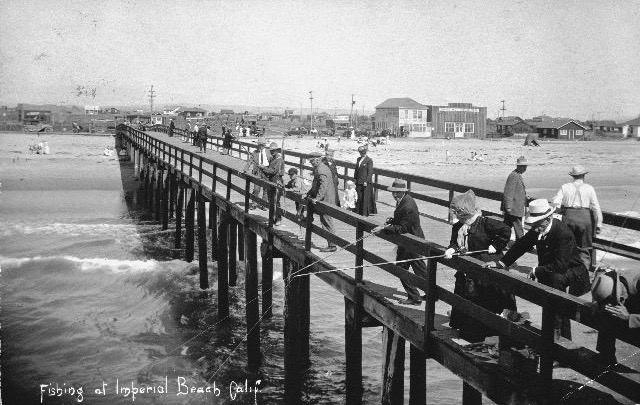
Passengers would ride the San Diego and South Eastern Railway to Otay Junction, today’s Main Street in Chula Vista, where they would transfer to the Mexico and San Diego Railway to finish their journey to Imperial Beach.
To power the electric cars, six wave motors, designed by Charles E. Edward, were built on a dogleg extension at the end of the pier, and, so, for a period of time, the pier was called the Edwards’ Wave Motor Pier. Excess electricity from the motors was sold to subscribers.
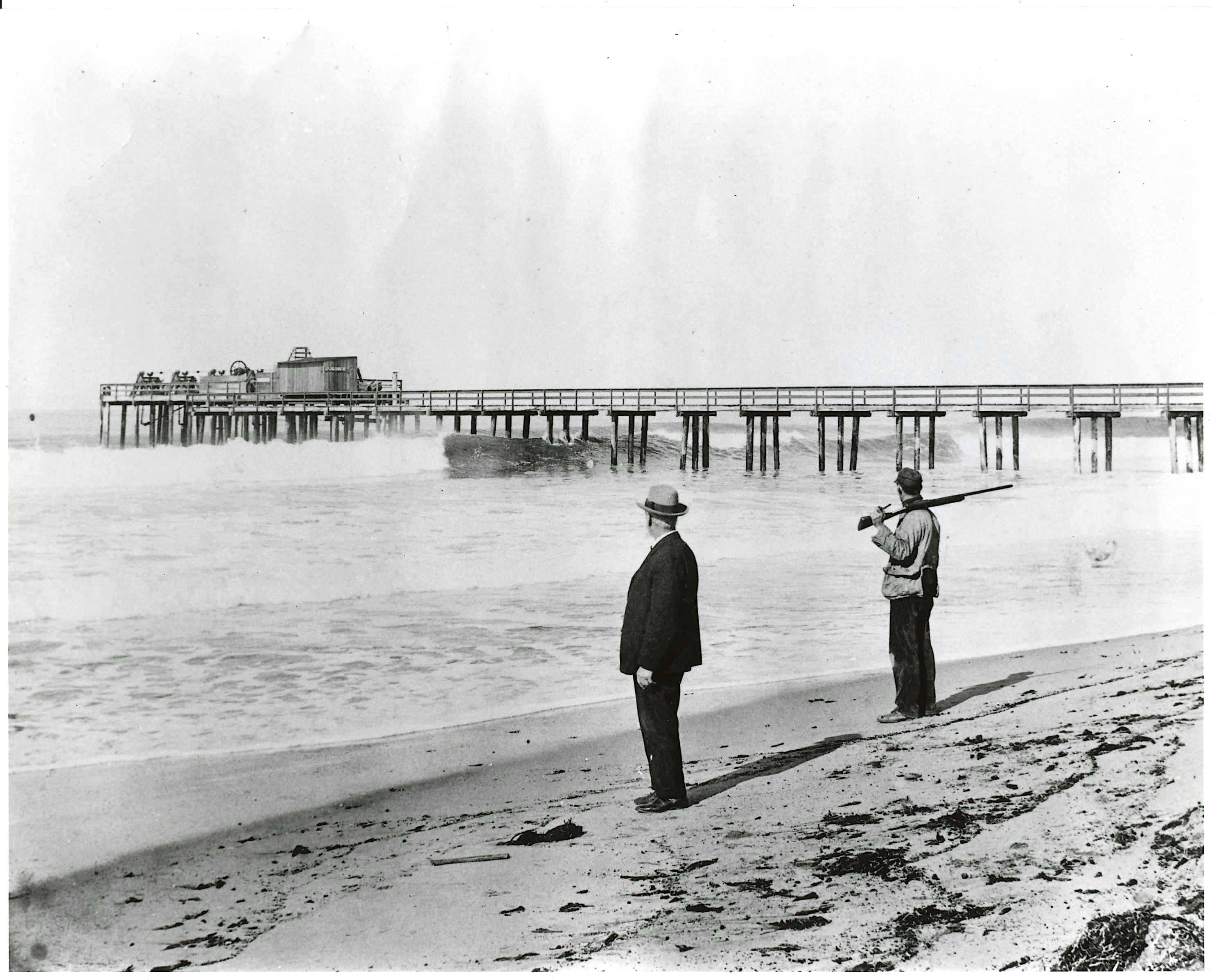
Pier with wave motor machines that helped supply electricity to the area
Eventually these wave machines lost favor but the pier continued to be used for recreational fishing until 1941 when the pier was damaged by winter storms. In 1948 storms finally washed the pier away for good and then, in 1953, the boardwalk suffered a similar fate.
Ten years later, in 1963, the new Imperial Beach Pier was built, a 1,200 foot-long-pier that was longer and much more extensive than the original.
In addition to the pier fishing, one of the attractions was the sportfishing landing that operated from the wide, T-shaped end of the pier. Half-day fishing trips to the rich waters of the Coronado Islands were soon offered on the 45’ Sea Scout and the 50’ R-Zee. It was less expensive, as well as a much shorter trip, than those offered by the landings found in San Diego Bay.
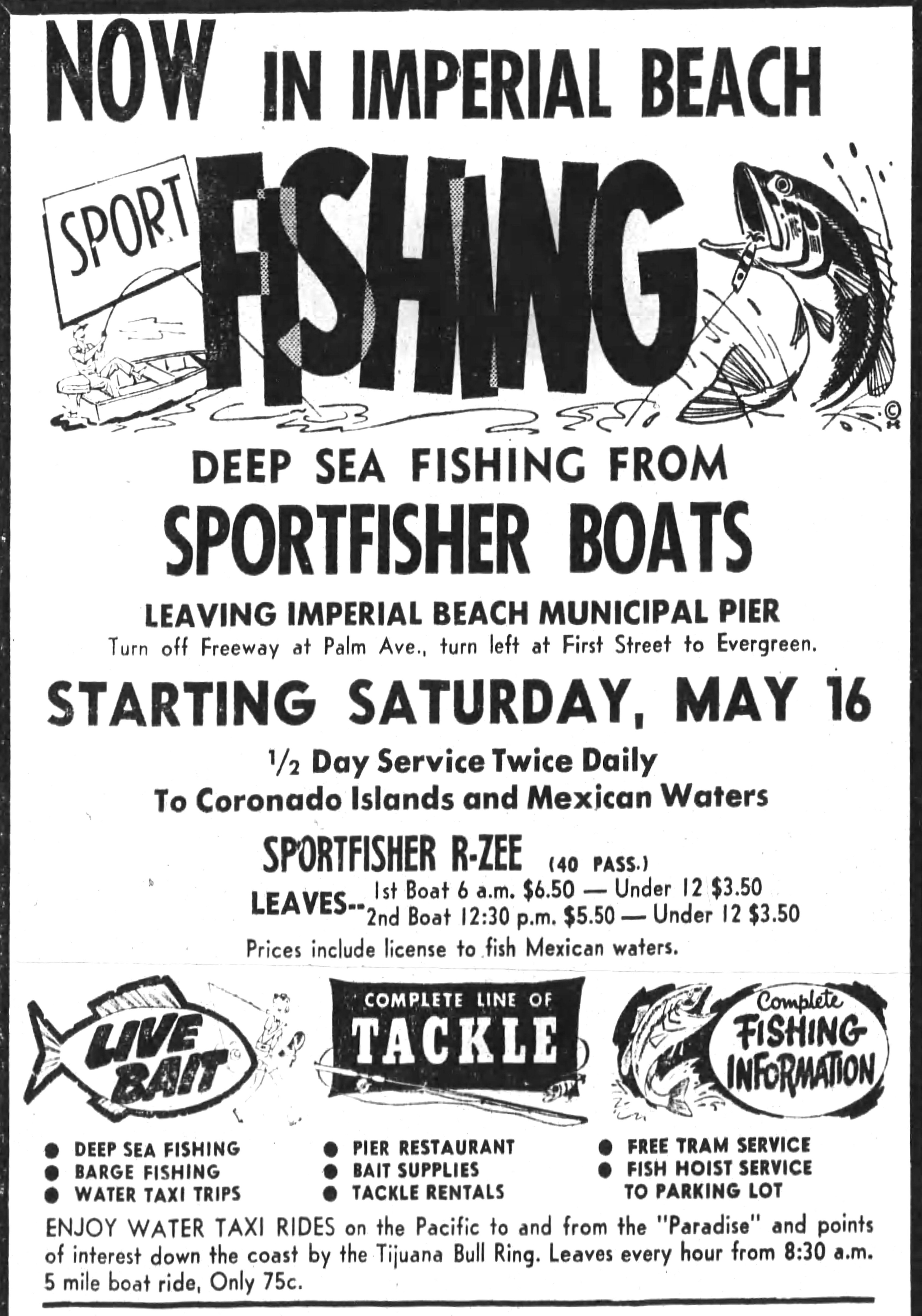
An ad from the Chula Vista Star News on May 21, 1964
Eventually the 65’ City of Imperial Beach additional was added to the fleet.
Date: April 3, 2007; From: Kathie Morgan, Fish Sniffer Magazine; To: Ken Jones; Subject: Imperial Beach Pier Fishing
Whether the R-Zee was first or the Sea Scout, or maybe both at once, they were already running off the pier while Zachman was having the City of IB built. I remember it was the first time I ever heard of a concrete hull. Twin 671 GMCs, if I remember right, and NO WHEEL, just a little lever to push this way or that.
Dick owned all three boats, and I caught my first ever yellowtail off the Sea Scout, operated by someone other than R Zachman. Dick seemed to prefer the R-Zee until the City was built. I never saw such a captain for going fishing, never. A morning half day trip might get back after dark. I remember one day we chased tuna down to Isla Todos Santos, on the half-day trip, finally connecting off Punta Salsipuedes on the way back.
Another memorable day was white seabass fishing with a boatful of jockeys from Del Mar, who caught over 100. I couldn’t BUY a bite. I deadheaded or worked the galley there for several years. Dick would moor the boat offshore the pier and he and the crew would get into a little boat and leave me out there alone all night. It saved me the cost of a motel room.
Another story regarding the partyboats, and their catch at the pier, comes from Tony Peña the noted authority and author on Baja fishing. .
“The late Joe Zarolla, a waterfront character of renown, revealed a pet lure in the sixties called a “vivif” which was a funny French version of today’s plastic tails with a broad paddle similar to a porpoise. After the laughter settled down Zarolla proceeded to catch a limit of yellows to 29 pounds on a June 28, 1968, half-day run on a party boat that operated from the Imperial Beach pier. Zarolla helped pad the boat’s catch of 123 yellows that morning because he led infuriated, hard charging yellows bent on killing his gyrating surface lure within reach of baited hooks.”
— Tony Peña, The Roving Angler, The Coronado Islands — Legendary Gateway to Baja
Yellowtail bite big; Anglers fill bags
Anglers aboard the City of Imperial Beach excursion boat this week collected 140 yellowtail off the Coronado Islands, the largest one-day catch since last fall. Jan Kahookela, office manager for the sports fishing concession at the Imperial Beach Pier, verified “It was the best catch for us this year.” Chula Vistan Jim Van Cleave Sr., among 35 persons on Monday’s morning trip , caught the biggest fish, a yellowtail estimated at 23 1/4 pounds measuring three-and-a-half-feet. The group caught 85 fish in the morning cruise while 15 persons aboard the afternoon trip collected 55, Kahookela said… “At one time, 15 to 20 people had fish going at the same time,” recalled Dave Croft of Monday’s catch on the Imerial Beach. “We lost quite a few (fish) then, with lines crossed and everything.”
—Chula Vista Star-News, May 28, 1977
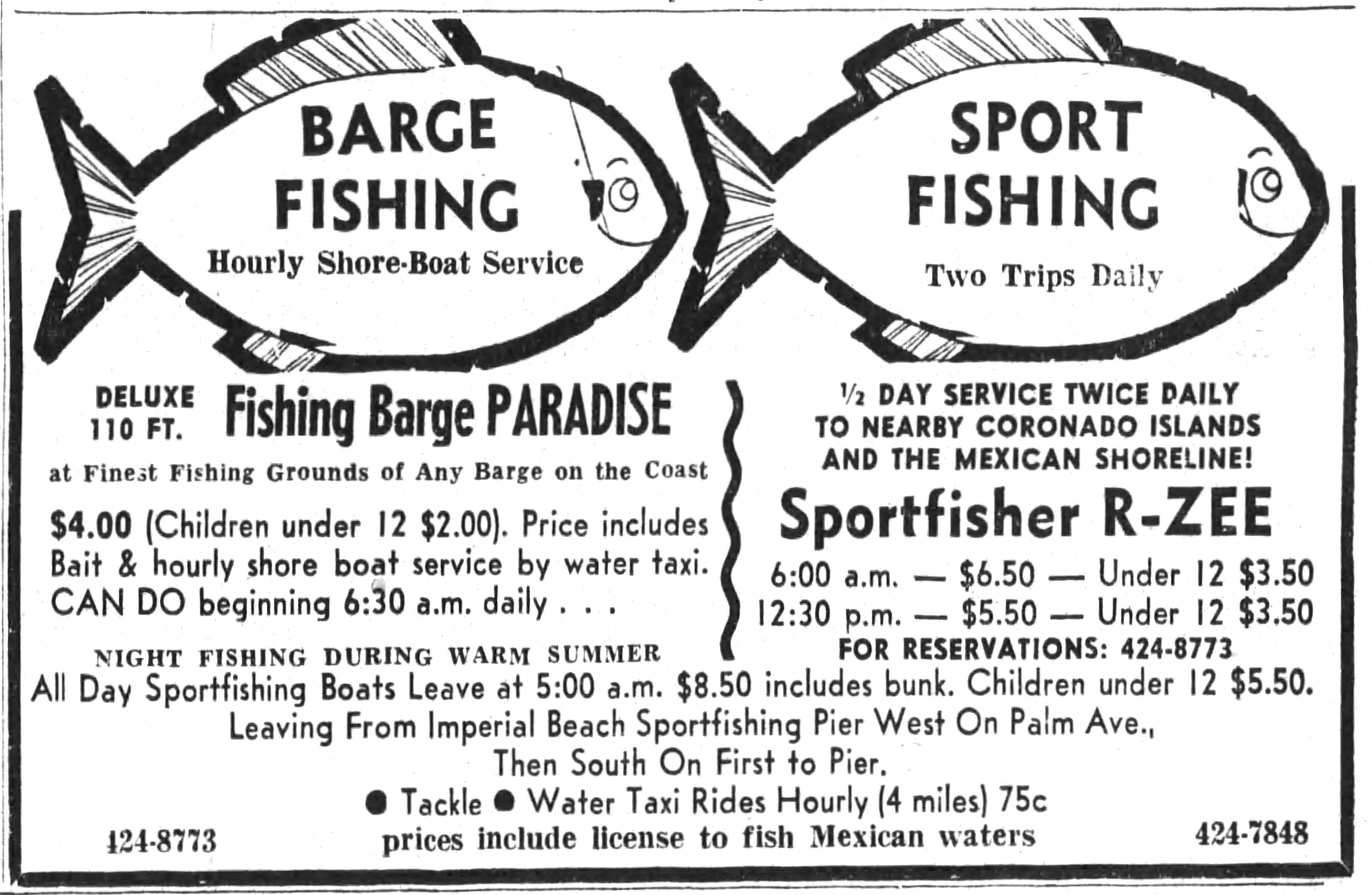
Unfortunately, the partyboat trips ended in 1983 after the pier, like many others along the coast, suffered considerable and repeated damage from winter storms. A 1969 storm caused damage, which necessitated the first reconstruction. Then, in 1981 storms destroyed nearly 250 feet of the 1,200 foot-long pier. Before this section could be fixed, the monster El Niño storms of 1983 damaged an additional 180 feet and weakened much of the rest. Finally, new damage in 1985 seemed to portend the possibility of an ending to the pier. Most of the pier was closed to public use in 1986 and one of the favorite resources for local anglers was in danger of being lost.
However, after much planning (and fund acquisition), work to both restore and enlarge the pier was begun. Although the $2.8 million dollar project nearly bankrupted the City of Imperial Beach, the now 1,491-foot-long pier was officially re-dedicated and re-opened in March of 1989.
Although the new pier was lacking the wide T-shaped end, it included a 31-foot height and steel pilings to give added protection. Facing a financial crunch, the city asked the state to help in paying for the costs of repair. As a consequence, the state allowed the San Diego Unified Port District to take control of the city’s tidelands and pier with the Port inheriting the $350,000 annual payments. In addition the Port committed to spend $10.5 million on a variety of projects in Imperial Beach.
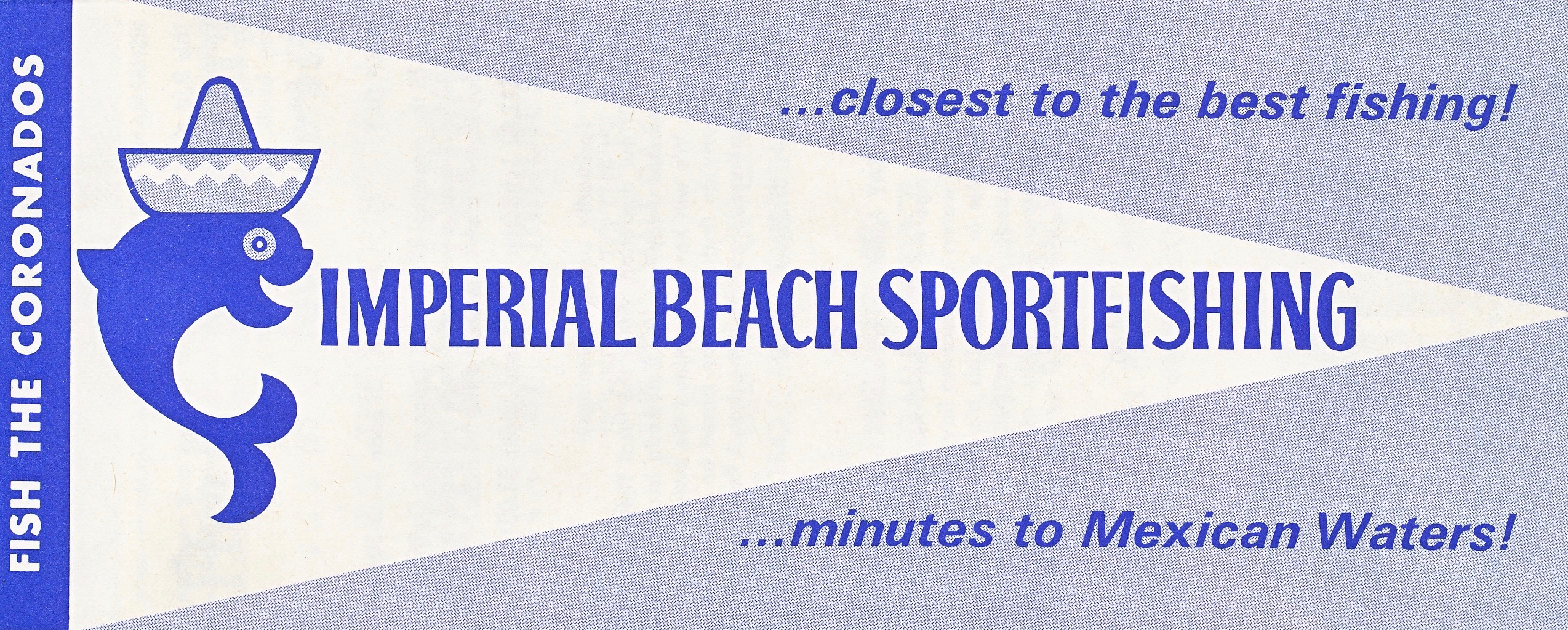
In 1997, $100,000 was spent to build a special loading ramp under the pier for the Morning Star Sportfishing fleet. Anglers could board the 105’ Bright and Morning Star or the 65’ Morning Star and in less than 40 minutes be fishing at the Coronado Islands. Unfortunately the operation was short lived, lasting less than a year; rough seas just made it too difficult to load boats
Two years later, in 1999, the port completed the $2.8 million renovation of the pier area, called Portwood Pier Plaza. Included were new shops and the bright, multi-colored, surfboard-like sculpture Surfhenge that graces the entrance to the pier.
The Port has continued improvements and upkeep including replacing several piles in 2006. Today, the pier is in generally excellent shape.
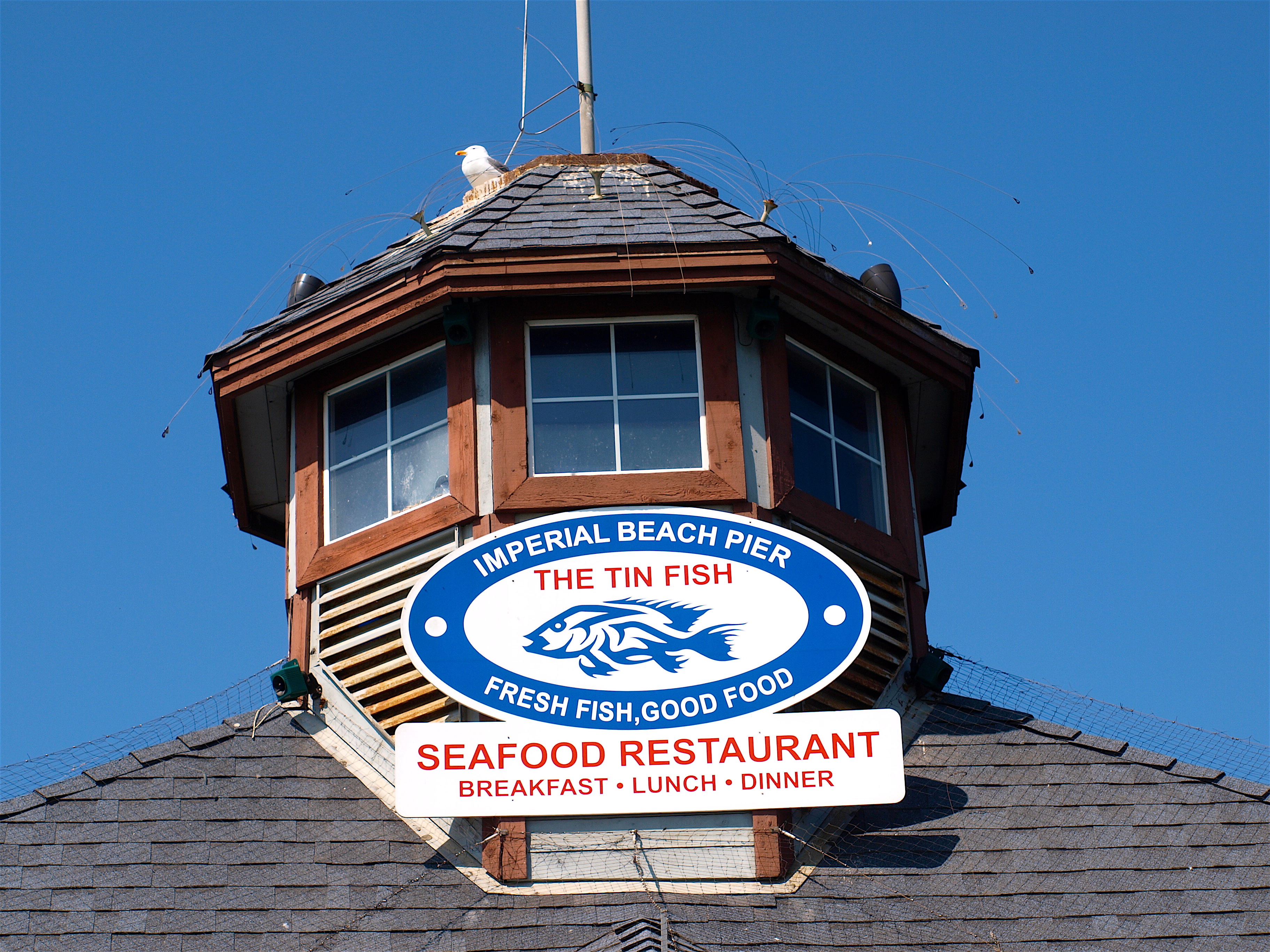
The Tin Fish restaurant sits out at the end of the pier offering up some good food (and limited bait). Unfortunately it also sets up tables and blocks off a fairly large section of the pier.
Imperial Beach Pier Facts
Hours: Open from 5 A.M. to 10 P.M. with a curfew enforced in the area after that time. However, the end section of the pier is controlled by the restaurant and often that area is not opened until after 9 A.M.
Facilities: Restrooms, fish-cleaning stations, benches, and night lighting. Unlike most SoCal oceanfront piers, parking here is usually available and it’s inexpensive. Some free parking is available on adjacent streets. A parking lot is situated near the foot of the pier; cost is $2 for all day except after 5 p.m. when there is a charge of only $1. Bait and tackle is available at the Argus Village Market directly across the street from the pier. If the kids get tired of fishing there are very nice playground facilities near the front of the pier.
Handicapped Facilities: Several handicapped parking spaces are found near the front of the pier as are the restrooms, which offer handicapped facilities. The surface is wood planking and the railings are 41 inches high.
Location: 32.57944 N. Latitude, 117.13417 W. Longutude
How To Get There: From I-5 take the Palm Ave. (Hwy. 75) exit and follow it to where Palm Ave. and Hwy. 75 divide. Follow Palm Ave. to Seacoast Dr., turn left and it will take you right to the pier.
Management: San Diego Unified Port District.
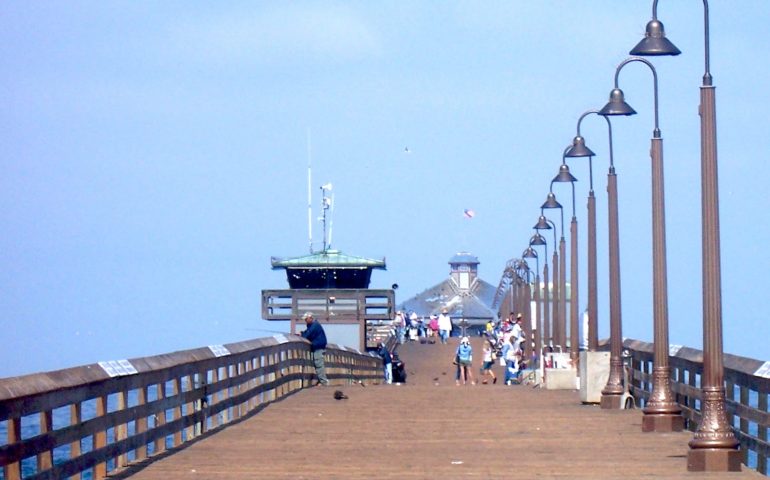
I must say I’ve never read a more accurate article about Imperial Beach ,
the Pier and it’s history. I’ve lived in IB my whole life and most of what I read about IB is bull. I fished on the R Zee and the sea scout with Dick Zacman and often worked as a deckhand or deadheaded. He was tough to work for because as your article says, some half day trips would last all day. He gave his customers 100% and wouldn’t call it a day till he found the fish or ran out of fuel. I was looking for Information about a shark that was caught on the Z Zee off the north Coronado island. It was donated to Scripps . I was on the Boat when the shark was first seen. Zachman was determined to catch that monster and set out on a crew only night trip. He was successful at hooking several but only boated one. The full story about this shark hunt would take to long to type. I just wanted to thank you for your article it brought back some great memories. There’s alot more about D.Z. some good some, not so good. Maybe some day someone will write more about the good old days on the R Zee. thx again.s